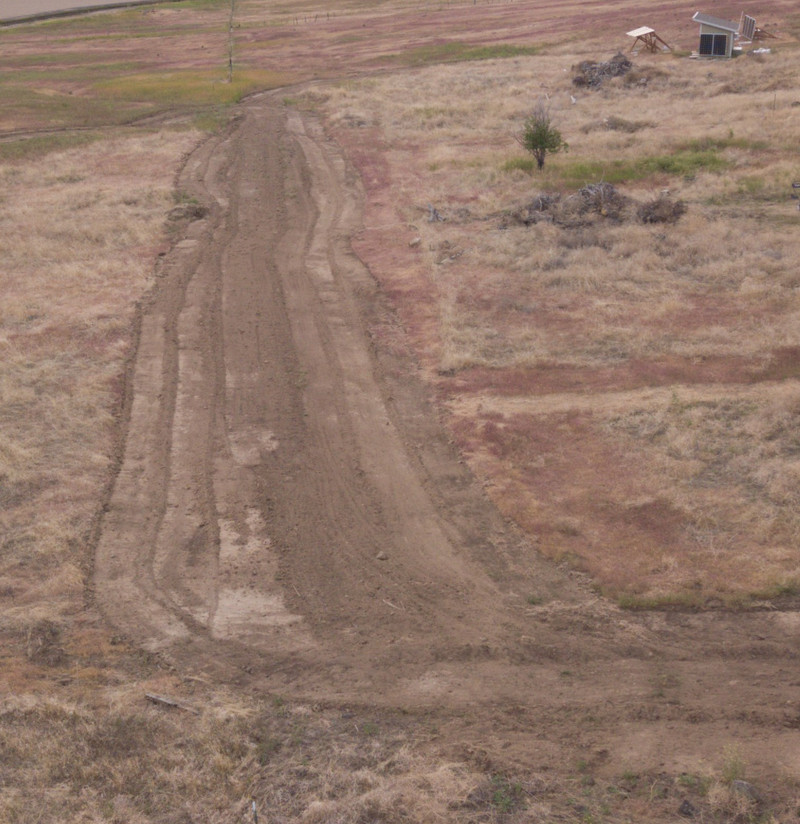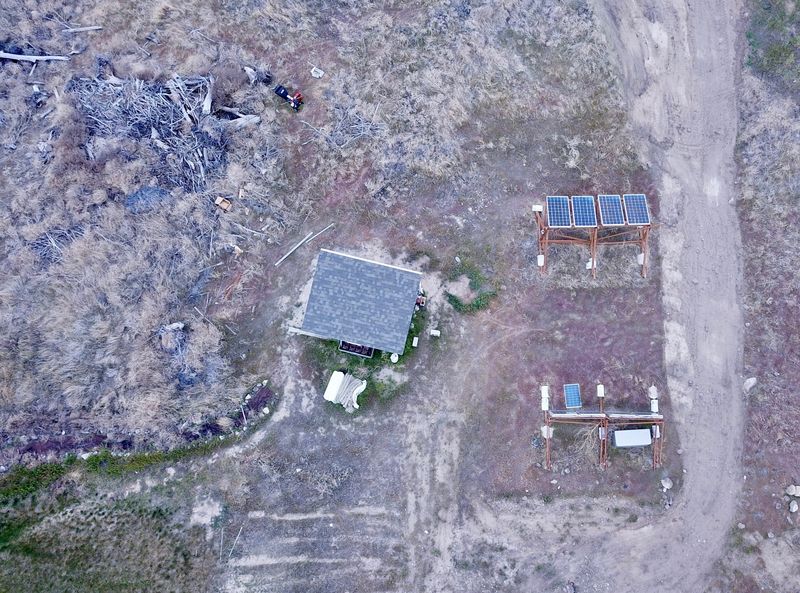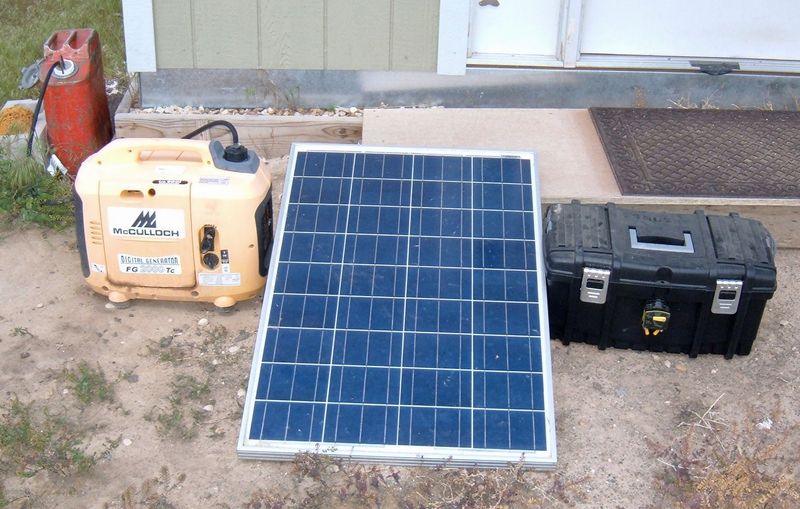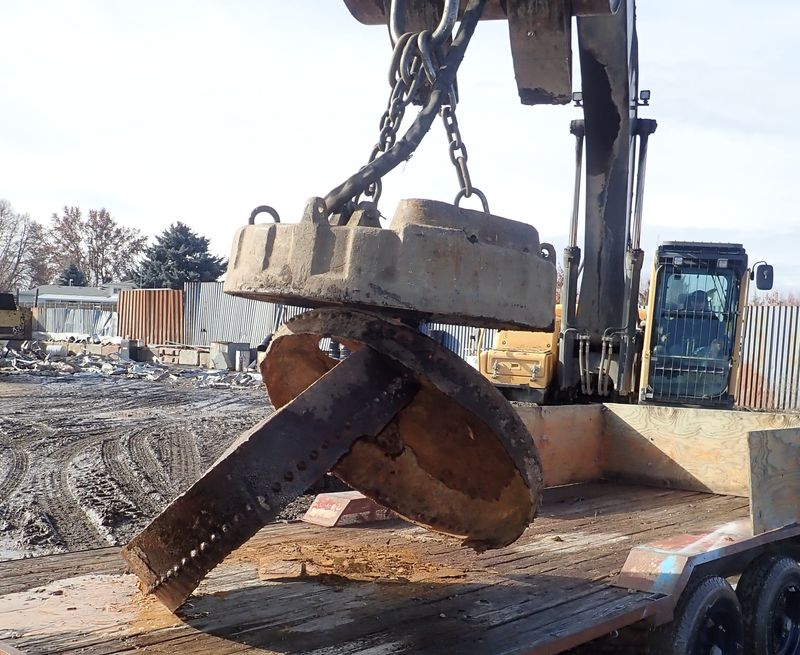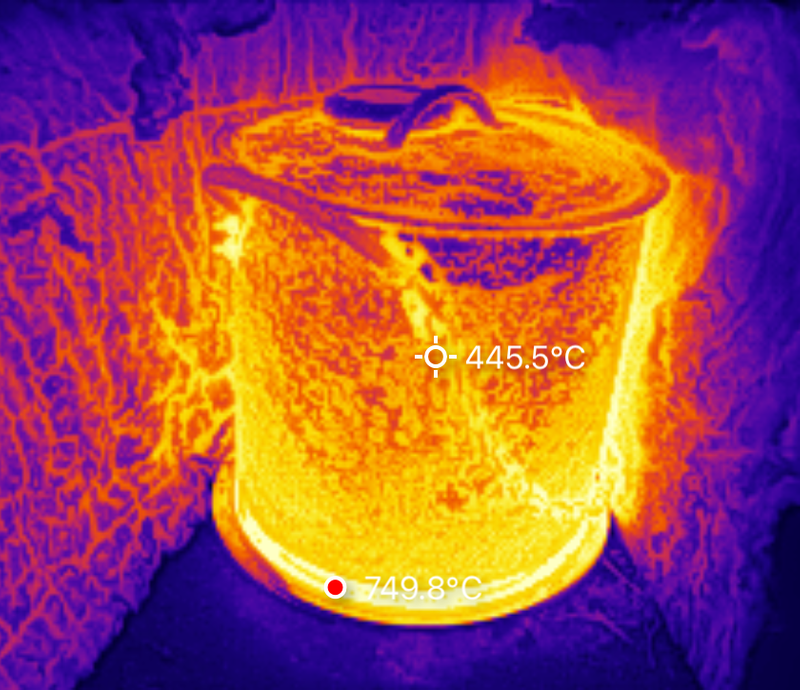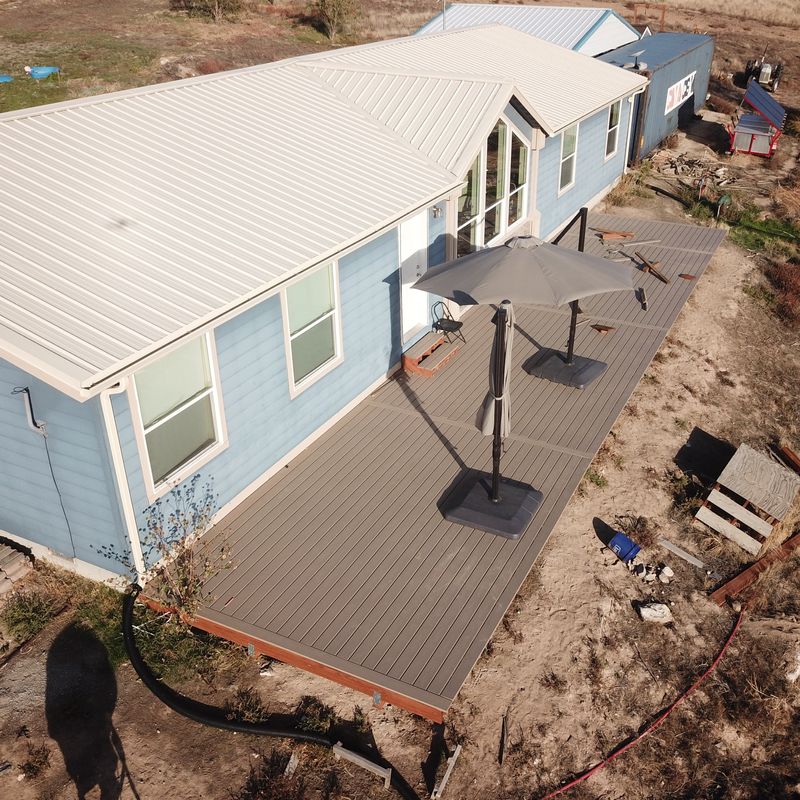A few weeks back, I started out with my “PIREPS” series of posts - thoughts and photos from random trips I’ve made via small airplane.
This post starts a somewhat infrequent series of “property updates” - general updates on our property, and some feedback on what has or hasn’t worked particularly well for us. Some ideas have worked wonderfully, some… haven’t. It’s hard to find anyone else who documents similar projects online, and I’d like to help fix that where I can.
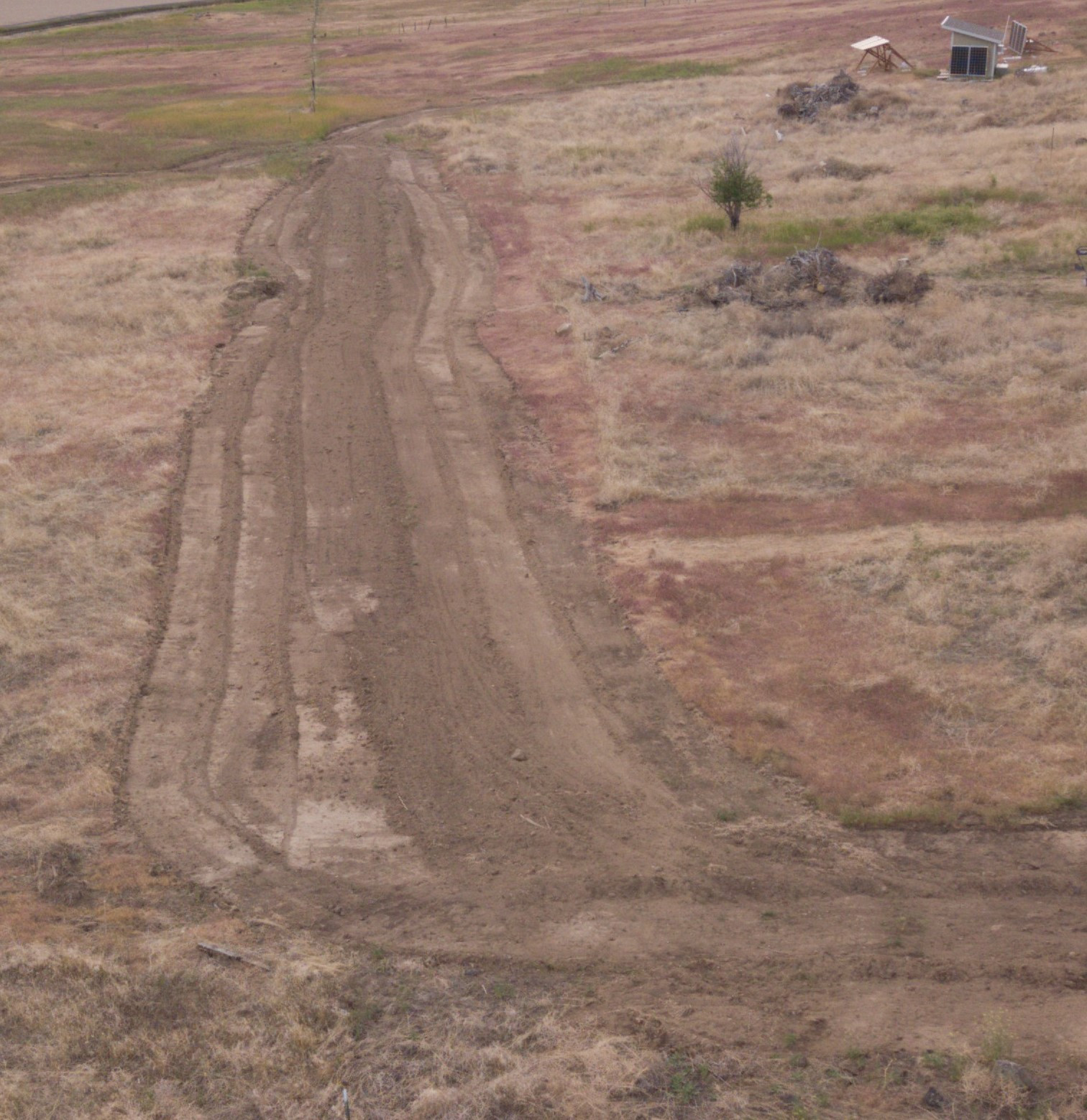
Curious as to how the trash trailer is working? How about what I’m doing with that ancient tractor I own? Well, I answer all that, and more! Read on!
A Few Acres of Basalt in Idaho
For those who haven’t figured it out, I don’t live in Seattle anymore. Yes, I’ve done posts about ebiking in Seattle, and I used to live there, but I don’t live there anymore, and I really didn’t like that area anyway. Back in 2016, my wife and I said “Enough of that nonsense” and moved out to rural Idaho. Some saw it as “the middle of nowhere.” I don’t agree. We’re in rural farm country, and I can see neighbor’s houses. We have a good view of the middle of nowhere, and somewhat regularly head out there, but we definitely don’t live in it.
However, I’ll certainly agree that I live on a few acres of basalt, covered by a thin layer of dirt. Yes, I know the difference between soil and dirt, and it’s dirt. Crushed up bits of basalt, and the only stuff that likes living in it is tumbleweed (of quite a few varieties) and cheatgrass. If you’re not familiar with those things, count yourself lucky.
The most common varieties of tumbleweed aren’t native to America. They showed up in the late 1800s from Russia. So, some of the cowboy movies with tumbleweed aren’t historically accurate. However, if you’ve seen someone running from a tumbleweed most of their size, that’s real. It’s worse when you’re little. My daughter has, on occasion, found herself up to her neck in tumbleweed (“mean weeds”).
But, in any case, this is the land we live on. It’s cheatgrass. It’s basalt. It’s… depressingly combustible late in the summer. And this is what I’ve set out to make something of, because, well, it’s what we have - and, importantly, it’s near family (which we value greatly, especially with a kid and another on the way).
The Temporary Stairs
When we moved in over 2 years ago, I built some temporary stairs. Some out of cinderblock, some out of lumber. They met code for an occupancy permit, they were functional, and… well, they’re still here. They’re good enough, and other things got in the way.
How have they held up? Decently enough, though the main stairs we use (access to our back sliding door, which is the main entry to our house) have sunk a bit and need rework. It was a challenge for a while for the kid. The main problem with the cinderblock stairs has been the water - I thought I had the sand compacted enough, and that wasn’t the case. They sunk a bit, and this has caused them to rotate slightly into our siding and pop the bottom board out slightly. It’s not an issue, but it does mean they’ve settled (and, also, the step into the house is noticeably higher).
The furball is our property cat, and the structure is a little cat feeder cover I built last year to help keep the rain out of the cat food bowl. It works well enough, though sideways rain will still get in. This particular cat was wandering around in late 2016, and we tried to attract it, but it had no interest. Sometime in 2017, it decided that our property was good hunting grounds (and we feed the cat as well), so it’s been hanging out. It’s mostly an outside cat, though I let it hang out in my office most days - out of the sun, and the cat just sleeps in a box. It took a few months of tossing the cat outside to convince it to not jump on my desk, but we’ve established an understanding now. Don’t jump on my desk, and don’t hack up a hairball inside. On more than one occasion, I’ve been listening to some variety of experimental music, and it’s taken me longer than it should to figure out that the odd counter-rhythm is actually the cat.
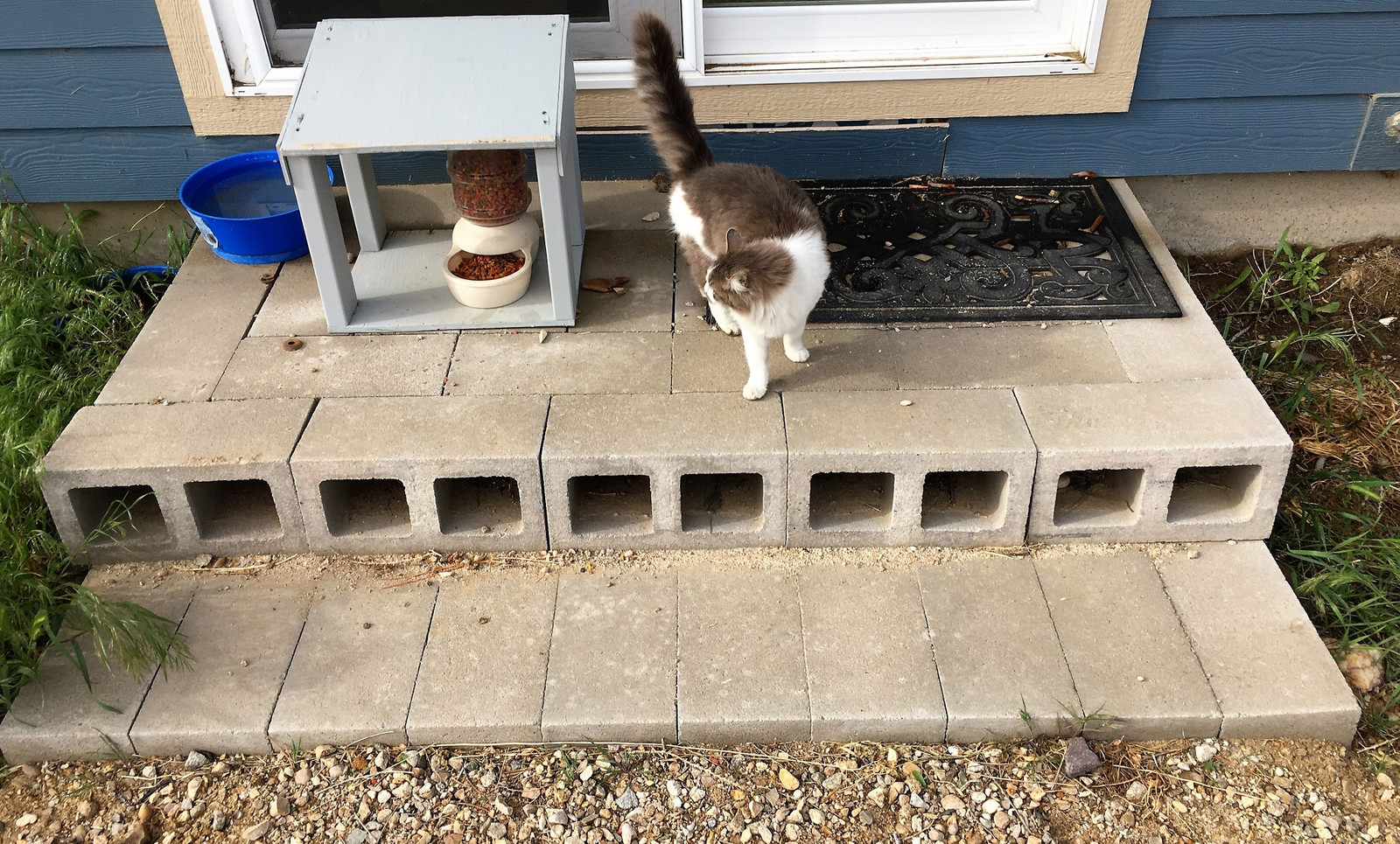
If you compare the stairs above with how they sat originally, you can see how much they sank in the rear (a few inches). The front hasn’t actually sunk as much - we just had the driveway done with a few dump trucks worth of road mix, and the new level is up to the base of the first tier (a mud pit outside the door is fun, but not really useful as a driveway when everything sinks in and you can’t get to the door without hauling in a few inches of mud on your shoes).
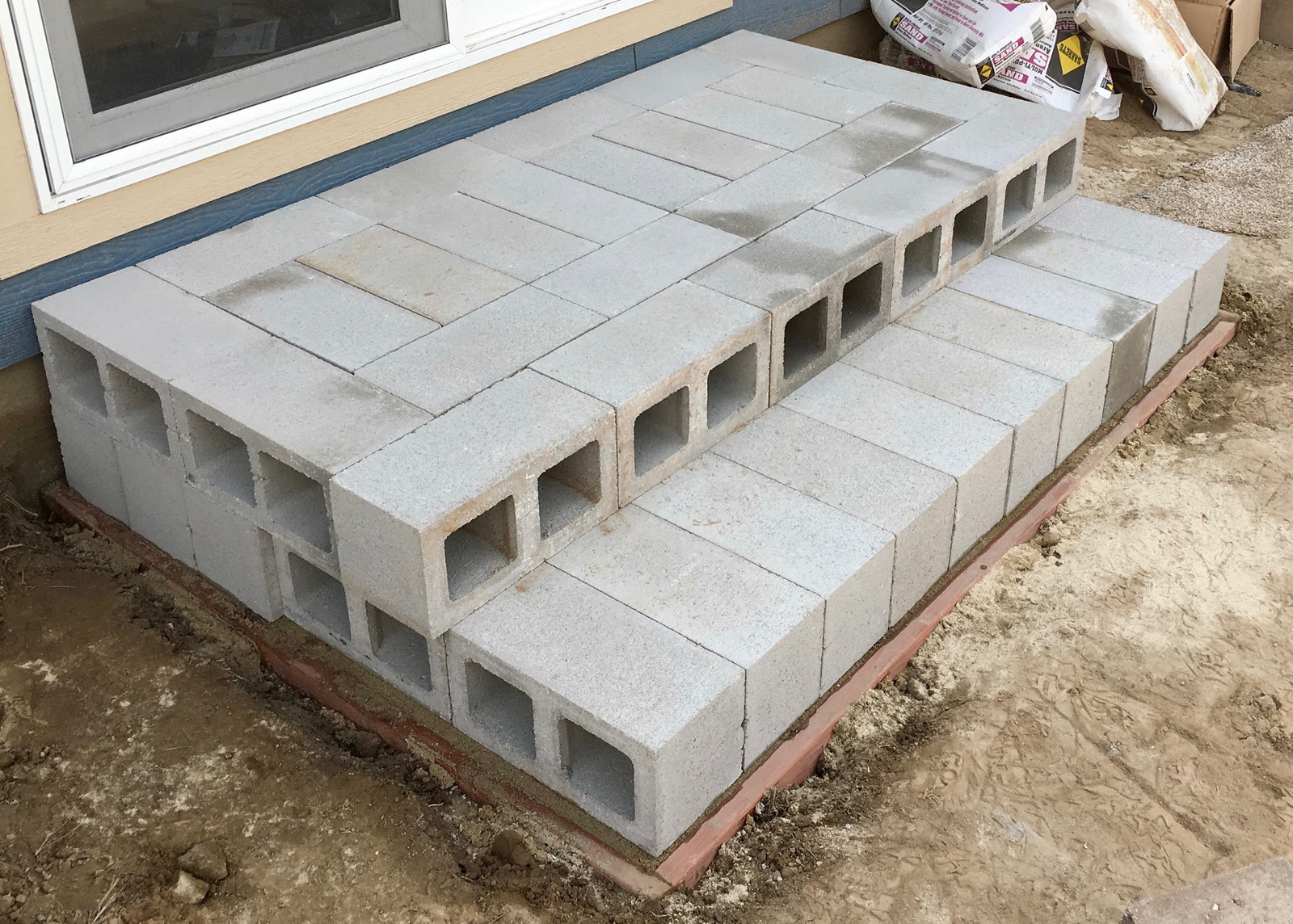
The wooden stairs I built for the front are working perfectly! They serve as a tiny little deck, and other than the plywood being a bit sunworn (south facing, totally unprotected plywood), they’re doing fine. We’re planning a deck out there, but time and money just aren’t there right now. With the absurdly rising cost of redwood and cedar, I’ll probably do it with one of the engineered materials (the new versions of Trex), but that’s not exactly cheap either.
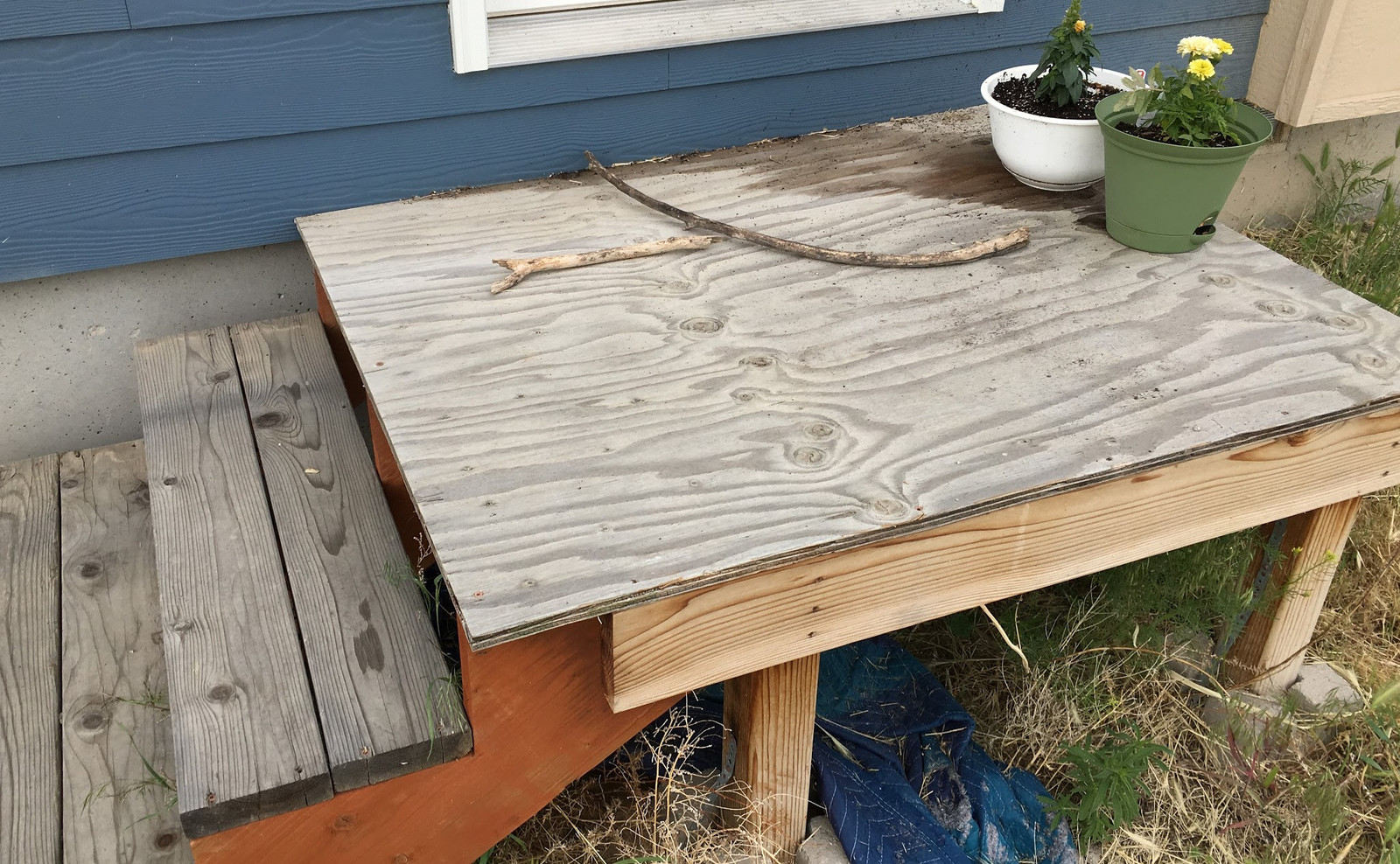
The Trash Trailer
Last year, I decided that I was paying too much in trash service (and hated hauling the trash up to the street every week), so I built myself a trash trailer out of some old stuff I found laying around (a mid-1960s pickup bed trailer and a mid-1970s camper shell). This creates a fully enclosed trailer that I can toss trash in and haul to the dump every few months (not on Saturdays, though - too busy). Use is fairly simple: Toss trash in it, and when it’s full, haul it and empty it.
How has this been working? Quite well! I canceled my trash service at the end of October 2017, and I hauled the trailer for the first time in early February 2018. It wasn’t full, but I had some other stuff to haul (trash from a banquet, which… I’m not at all sure why I even volunteered for that, plus a cheap couch that was absolutely falling apart), and I figured I may as well haul the trailer while I made the trip. It still had a month or two of space left, but the dump has a minimum charge regardless of how little weight you haul, and with everything, I was still under it.

By May, it’s about 75% full again (a good chunk of the bulk is from tearing down the ferret room that was in a bedroom and moving them into the bonus room on the end of the house - sorry, ferrets, upcoming kid gets priority), so it seems like the trailer will hold 4-6 months of trash at a time. I was paying $222/yr for trash service, and a round trip to the dump costs me about $8 in diesel and the $5 minimum charge (for up to 600lb of trash). Run the math, and you get $30-$40/yr in trash service, plus a few hours of my time, instead of over $200. The trailer ran me about $200 in build costs, so with $180/yr in savings, it pays off in a hurry. Yes, I know my truck costs more than just diesel to run, but it’s only 75 miles a year, so… not much, even at the IRS mileage rates.
Beyond just the money, it’s quality of life. I destroyed an ebike hauling trash cans up the driveway (sheared some bolts off), didn’t care for hauling it up by hand (the tiny trash can wheels sink into the gravel), and it just didn’t work well with the bursty nature of our trash. We’d have no trash for two weeks, then a lot, and it’s far more convenient having a large trailer to buffer all this.
So, for now, the trash trailer? I’m making a note: Huge success!
Property Boundary Firebreaks
Let’s go back to cheatgrass for a bit. It has a major problem come mid-summer: It burns. Aggressively. Quickly. The stuff is stone dead by June, and by August, it’s a tinderbox waiting for a spark. Such spark, not-really-hypothetically, could come from some muppet quite a bit uphill deciding to mow their cheatgrass field on the windiest day of the month. A wind blowing, let’s say, straight downhill. Towards our property. Now, I’ll let you do the math on “20+mph winds and bone dry cheatgrass,” but let’s just say it was more excitement than I care for. By a large, large margin.
On top of that, there’s 4th of July. We have an amazing view of fireworks - so good, that people like to park down our driveway to watch them. And then light off bottle rockets. There’s an iterative process here of keeping people from being stupid around our property, and I think this year, it involves me sitting on an old tractor with a shotgun, and an awful lot of custom “DO NOT LIGHT FIREWORKS” caution tape along the road. Seriously. Fighting grass fires in the middle of the day is bad enough that I just don’t want to fight a grass fire at night. One of these days, I’ll sanitize my writeup of the event enough to share…
But, the takeaway here is that grass fires are a problem I deal with. Historically, this hill is more or less on fire every decade, but recent data would indicate a rather disturbing increase in that frequency to “every few years.” I don’t mind a good grass fire if it’s well contained and away from structures, but that wasn’t really the case last year, and I had a desire to make sure that even if the hill does catch fire again, it wouldn’t be a major problem.
This is the sort of stuff I’m dealing with. It’s a blend of cheatgrass, mustardweed, tumbleweed, and probably a few other things I haven’t identified. By mid-summer, they’re bone dry, have a surface area to volume ratio of “Yes,” and happily propagate any sort of flame that comes their way. Or spark, or hot spot, or… whatever. It’s tinder - and not the kind you swipe on.
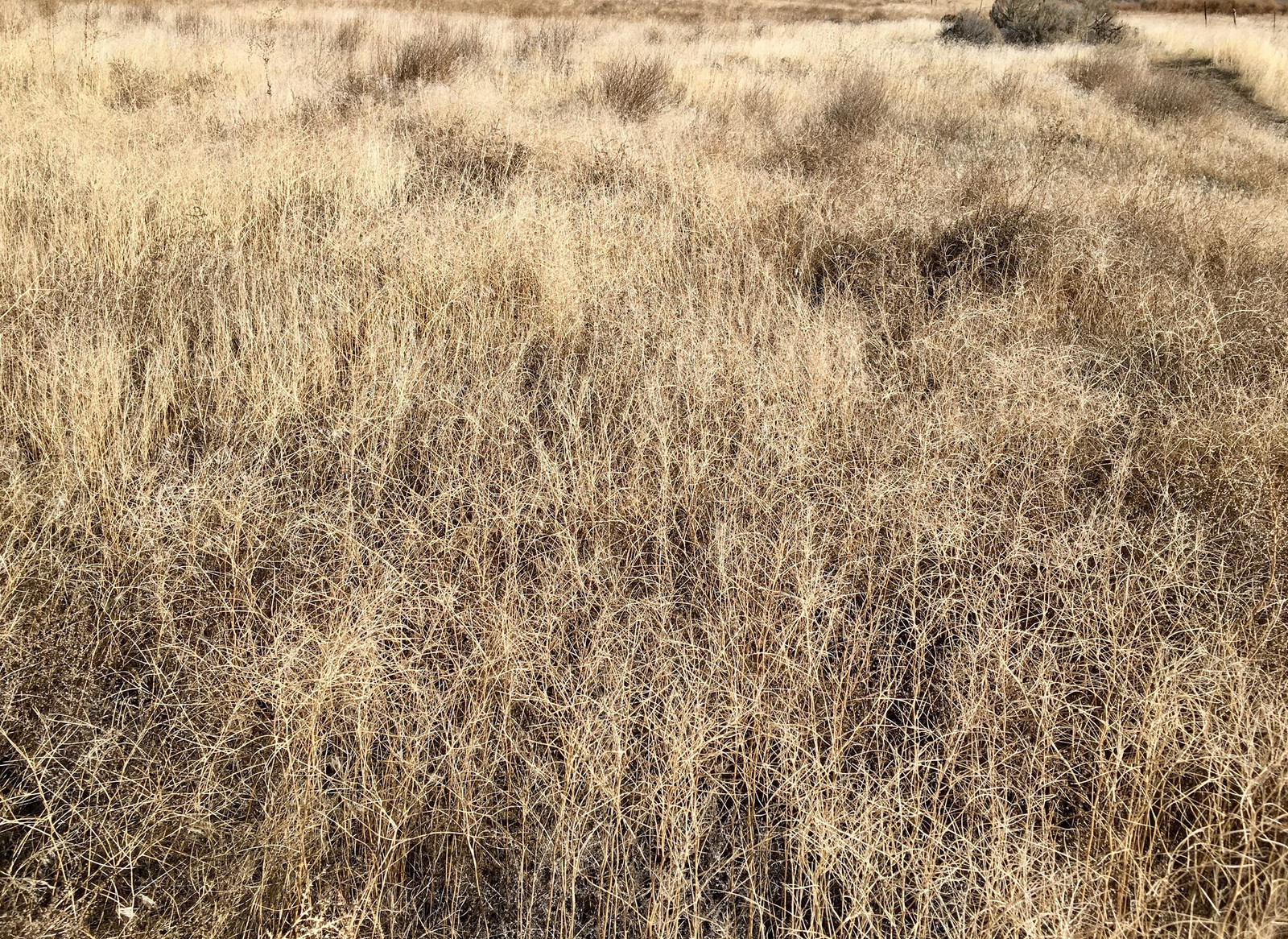
What that means, practically, is that I need good firebreaks to protect the property. A grass fire, for those unfamiliar, is fairly low on “burning material thrown into the air,” and fairly high on “direct radiant transfer from a fire front to more dead grass.” If you have a large enough region with no dead grass, the fire won’t cross it (unless you’re really unlucky). If it does cross it, it will be at one or two points, not the whole line.
Given all this, I decided to start early this year with cutting firebreaks. The wet dirt in February is easier to rip up than dry dirt, and that nothing was growing yet meant, hopefully, I could disrupt things before they got started.
Regular readers of my blog will recall that I have an old tractor. It’s a 1939 Ford 9N, with a whopping 23hp of fury (out of a 2L motor), and I spent a lot of time working on it last fall. This is my weapon of choice for firebreaks. I spent some time previously trying to cut fire breaks with a string trimmer (also featured on my blog - at 30 years old, it’s quite new), and evidence of the past summer indicates that this is nice to slow down a cheatgrass fire, but it’s really not at all sufficient to stop one. I needed to do more.
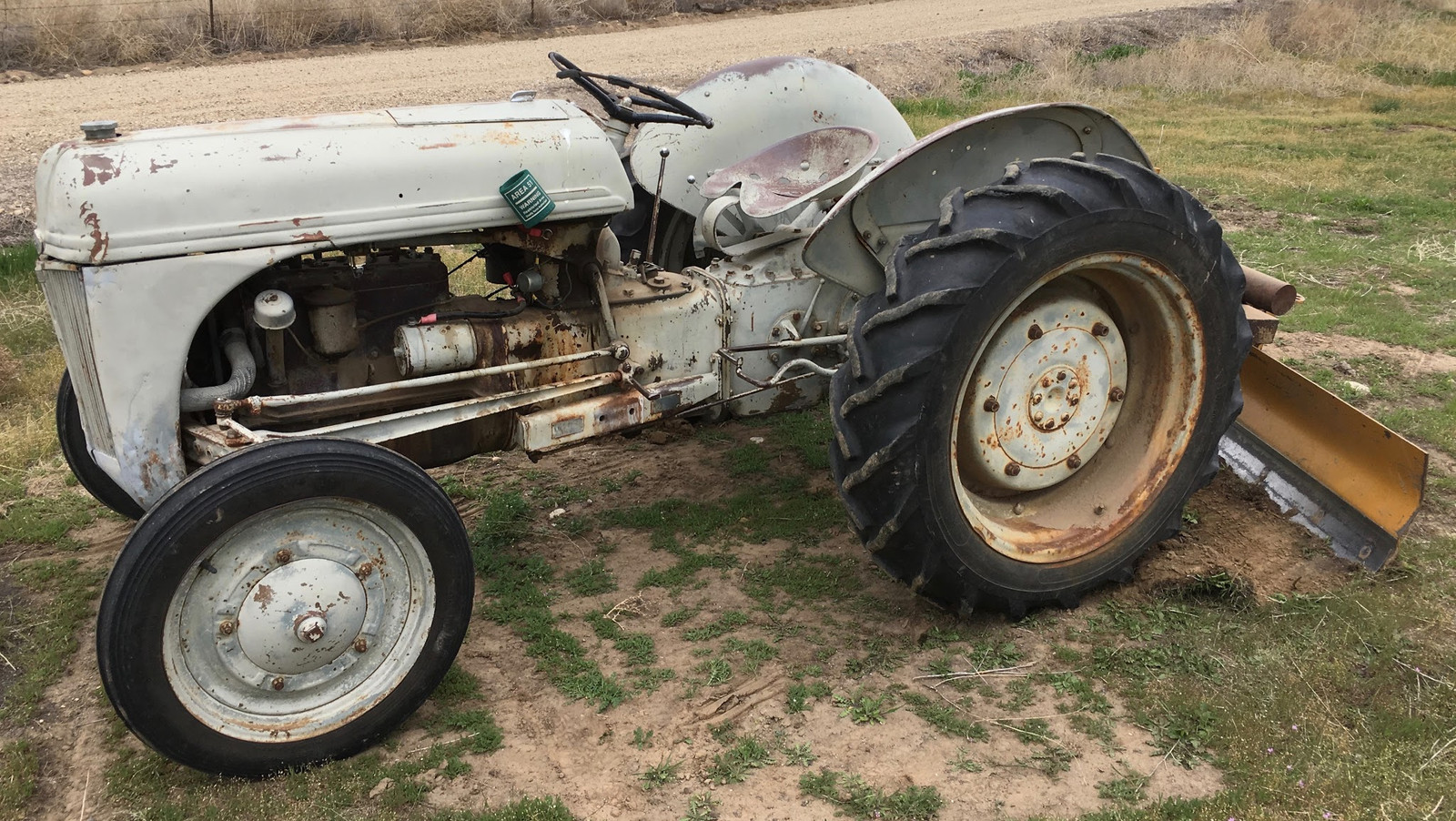
Initial attempts to rip up the dirt with the blade simply didn’t work. I could shove the draft control as far forward as I wanted (it’s a draft control, not a position control, which means it tries to maintain a constant drag force, not a constant position) and the blade would bounce over the dirt. The problem, since the hydraulics can only lift but not push down, was simply a lack of weight on the blade.
Recall that description of my property as “a bunch of basalt”? Basalt is heavy. My basalt is “foamy” basalt (lots of air bubbles in it), but it’s still very heavy. Throwing some rocks on the rear of the tractor, over the blade, really improved the blade performance. But, they also kept falling off - even with the ratchet straps over them.
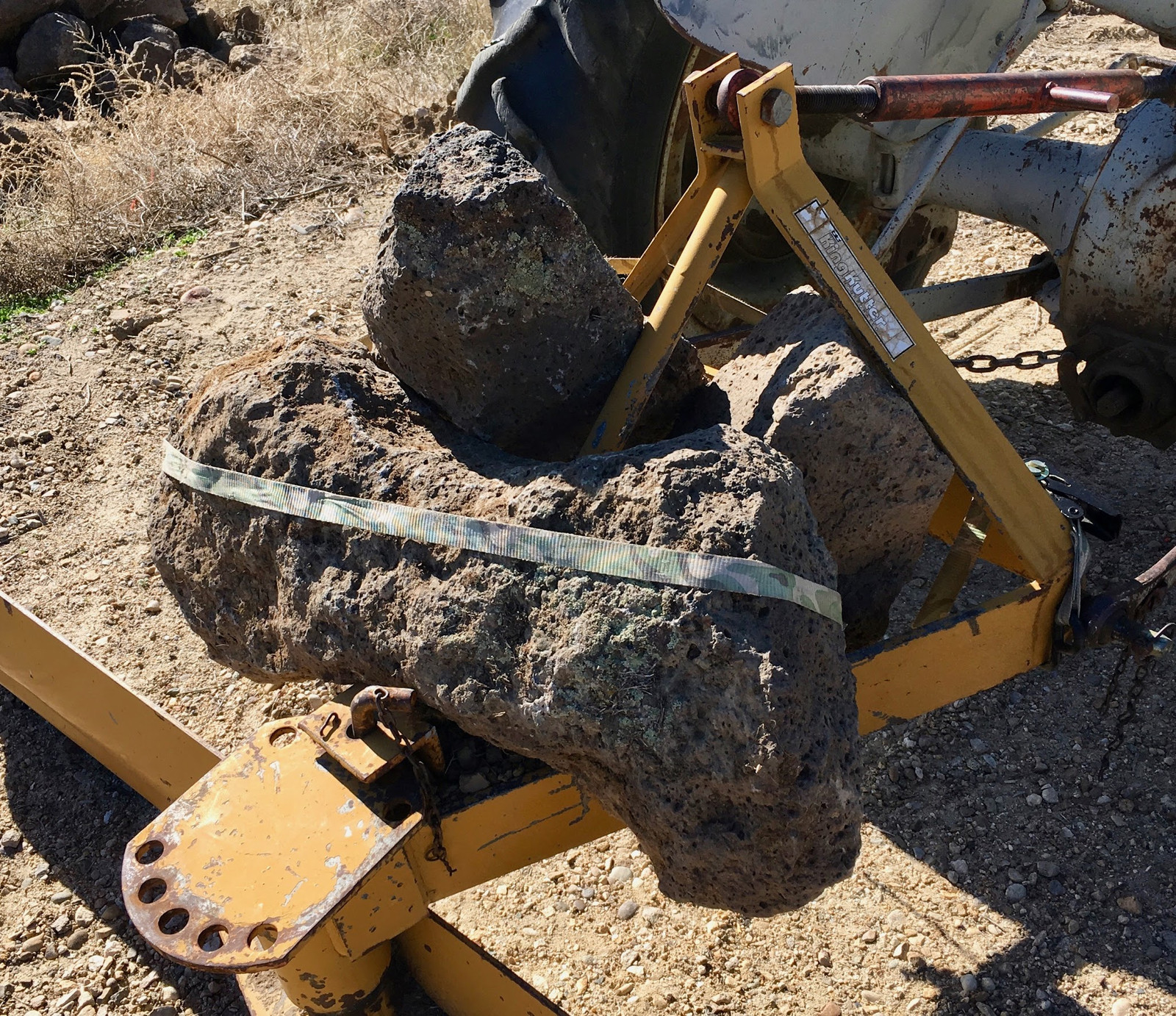
A quick survey of the local scrap iron field revealed some slightly more machined weight I could use that, hopefully, would not bounce off as easily. After ratchet strapping this down and playing around… I discovered that it was too heavy. The front tires didn’t exactly contact the ground if I was trying to drag dirt up a hill, and they barely contacted the ground a lot of other times. Yes, I can steer with the brakes, but having the front floating along barely touching the dirt is the sort of excitement I just don’t need in my life. There’s no rollover protection on this tractor, and I have no desire to die under a tractor that’s radically older than I am. The tractor, meanwhile, is the sort of machine that lets you know, on a moderately regular basis, that if you’re going to persist in being stupid, it’ll be judge, jury, and executioner, and it will wait for that one brief lapse of attention before starting the process.
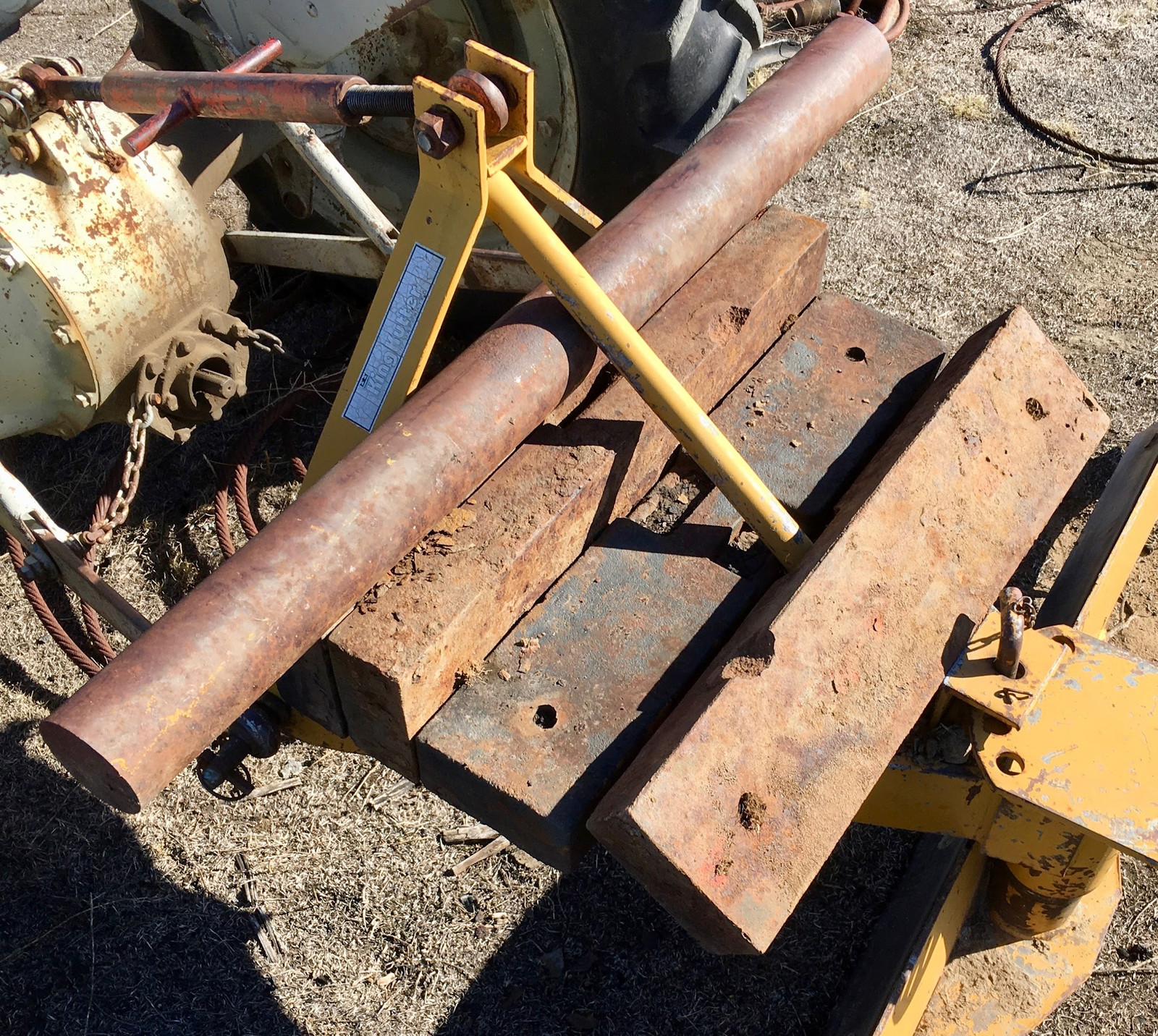
The right amount of weight is one scrap iron bar less than I had. With three scrap iron bars and a scrap iron cylinder, the blade digs in wonderfully, but the front doesn’t come up. I could find a way to load some counterweights on the front, but the front axle isn’t terribly strong and this configuration is plenty for my needs. If I dig too deep, I can’t drag it anyway. Remember, a whopping 23hp. Gear it down, and it’s still 23hp. I’m not sure how long those ratchet straps will last with this sort of abuse, but I suppose I’ll find out!
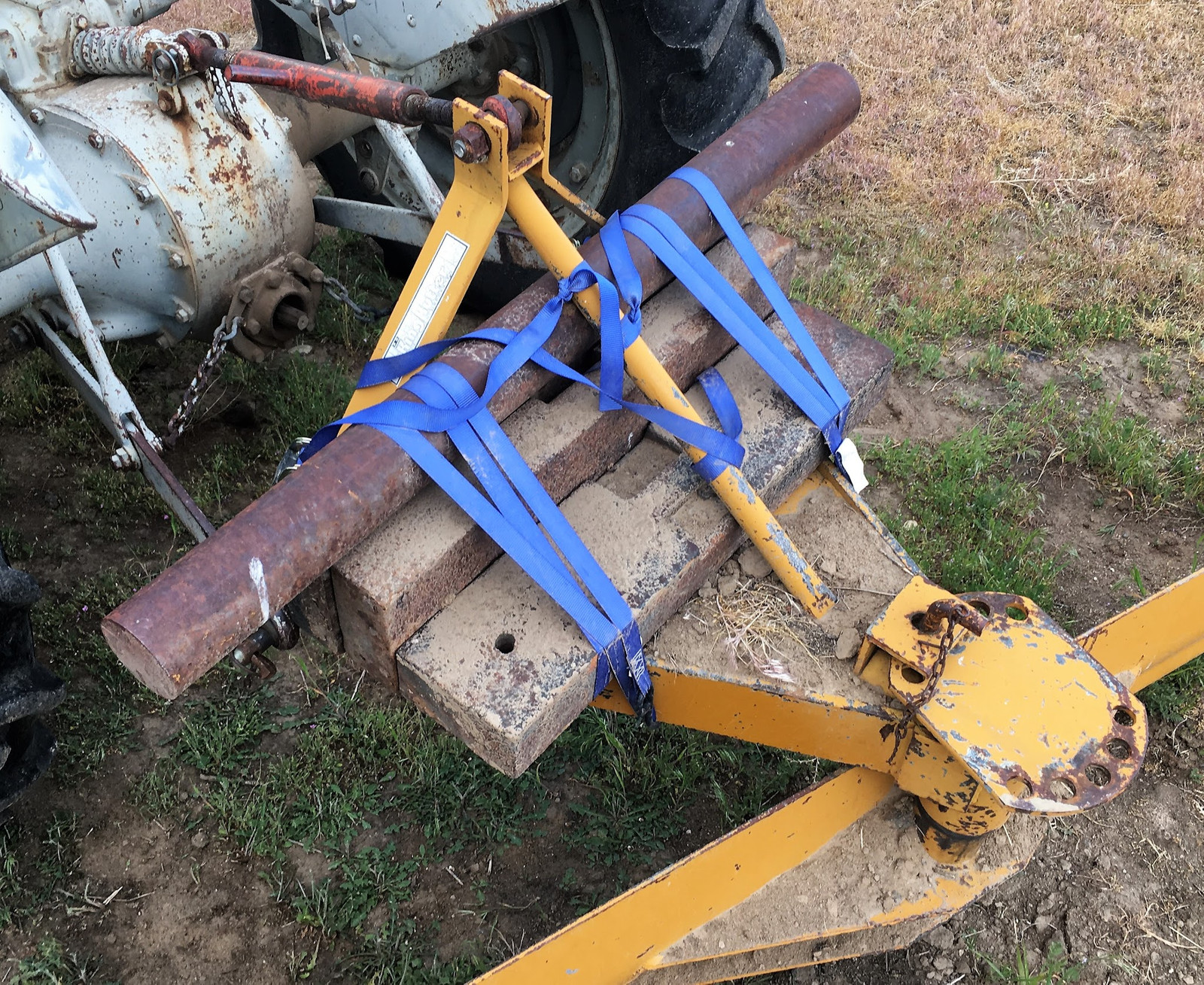
Cutting the Firebreaks
The last summer or two, I tried to cut some firebreaks with that previously mentioned string trimmer - and they got the grass short, but short grass still burns. My attempts were wider than this path (which I used for some drone testing last year), but fundamentally, short grass is a fire slower-downer - not a fire break. This is not good enough!
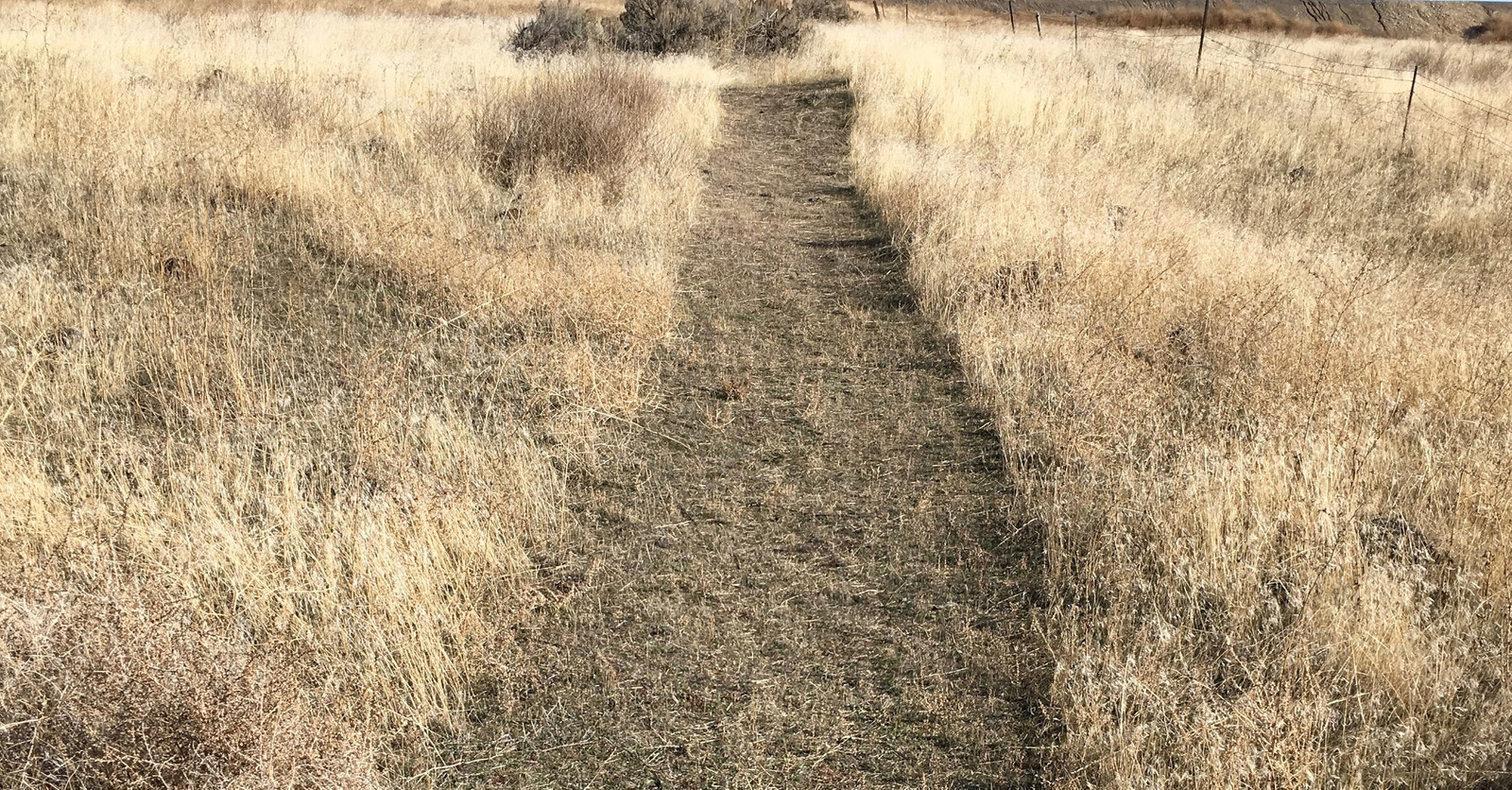
I started out, once I’d loaded the blade up enough to actually cut, by setting the blade to a fairly aggressive cutting angle, slanted to one side (so it will push dirt over), and running back and forth on some areas I’d already cut short the previous year. I ripped up the cheatgrass, and I ripped up tons of rock. A blade, digging into the ground, will extract all sorts of rock you can see, and an awful lot you can’t. The draft control will try to lift the blade, but I still stalled the tractor plenty of times in this early stage. This is really exciting, because it means that the tires did hook up against the ground (almost like ag tires are designed to grip dirt)! Clearing snow on an iced up driveway doesn’t stall the tractor, it just spins the wheels. Traction is awesome!
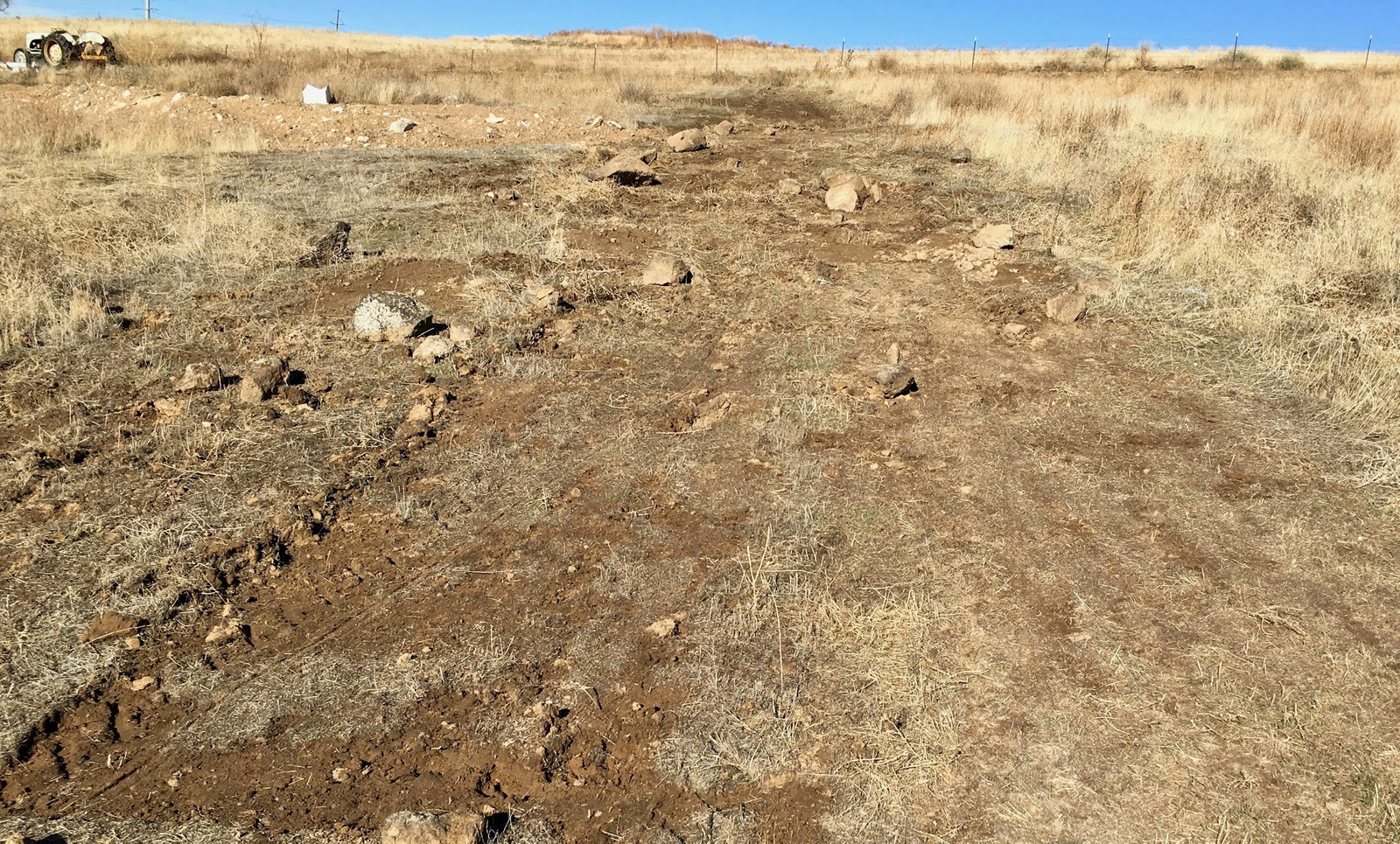
After I’d gone over a section of ground, what I found was dirt (somewhat moved), and rock. Lots and lots and lots of rock. Big rocks, little rocks, pebbles… all of it. Most of it was moved the surface, which is great for me - it makes it easy to pick them up, but they’re very much in the way.
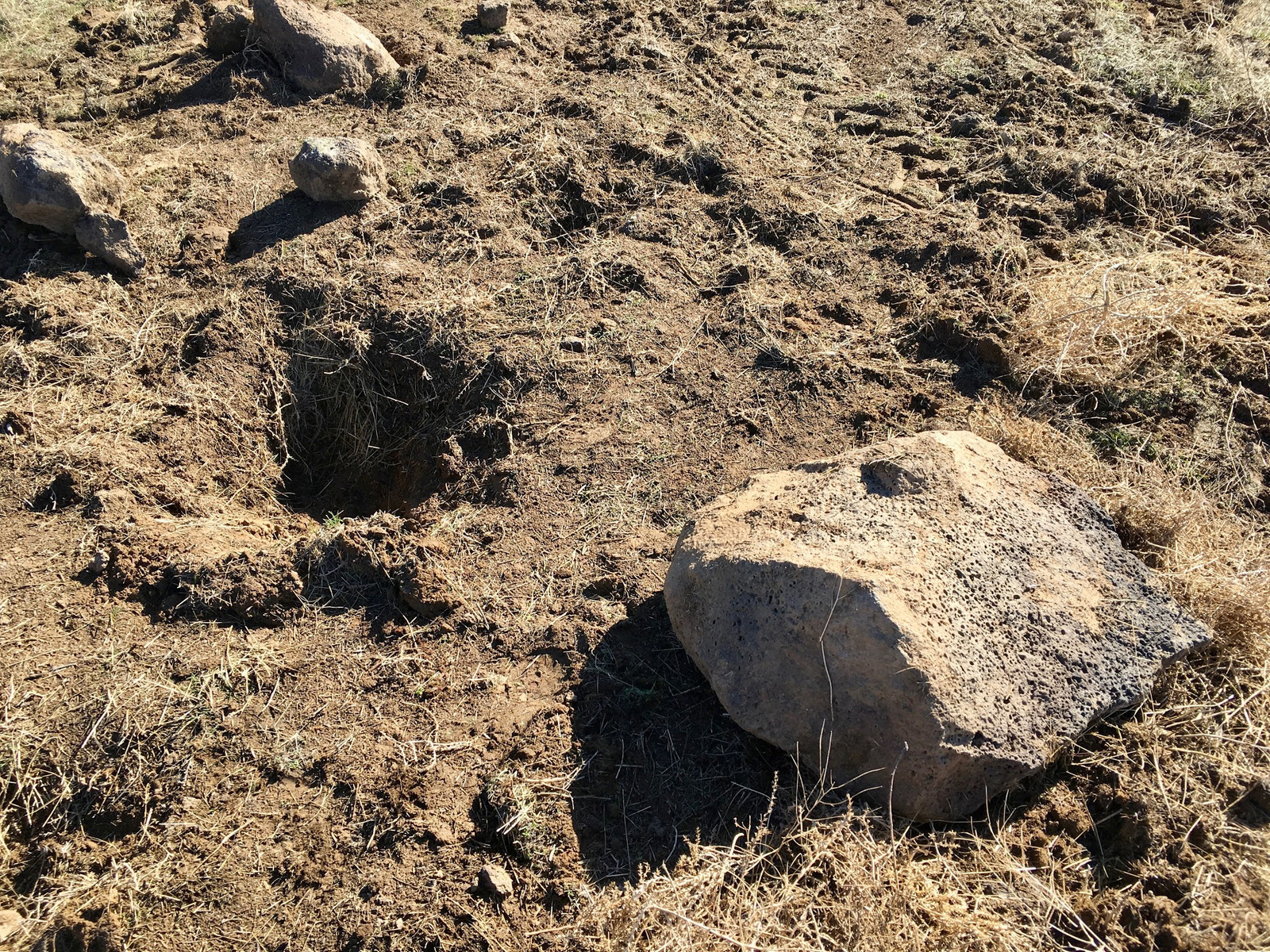
I proceeded to go through the areas with a shovel, prying rocks out of the ground. Some of the large ones I can’t lift, but can roll by prying (think 300-400lb of basalt). However, most of the rock can be lifted, if you’re willing to work at it. What do you do with tons of rock once it’s out of the ground and laying around? Well, whatever you want, but I put it in my truck.
I own a fairly large truck. This is a bad word in certain circles online. I don’t care. I like my truck. I use my truck as a truck. I somewhat regularly haul a 10k lb trailer for our church, and I do things like haul an awful lot of rock out of dirt paths I’ve ripped in our hillside. I use 4-Lo for this, mostly because that helps avoid digging ruts. This is one of many loads of rocks I’ve pulled out of the paths I’ve ripped.
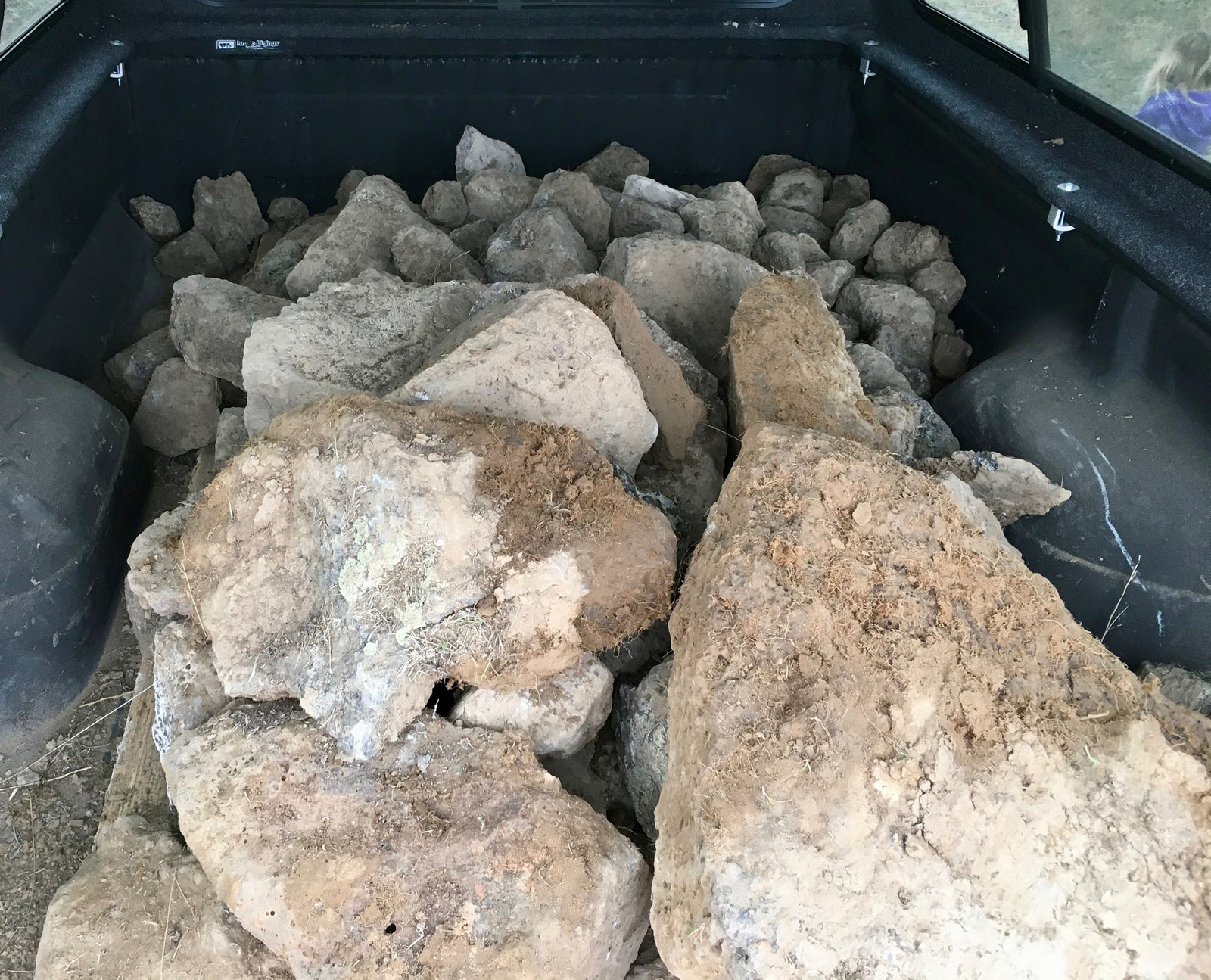
If a rock is too large to move, there are a few options. I can lever it out of the way and leave it. At some point, I’ll pick up some pin and feather wedges and a good rock drill, and split rocks in place so I can move them.
But there’s also a much simpler technique that works often enough that I make good use of it. If you were playing Kerbal Space Program (which, if you haven’t, you should), this would be described as something like “kinetic-gravitational lithofracturing.” Or, in more human terms, “throwing a rock down at another rock until it breaks.” Much like hitting a rock with a sledgehammer (which I’ve done a lot of), you continue until either you succeed or you give up. It’s one of those “brute force” things - if you use enough of it, you will succeed. But this is a great way to break up rocks in situ before hauling them off somewhere.
If you’re of a certain age, you could think of this as a particularly hardcore and violent version of pogs. If you have no idea what I’m talking about, well… just keep reading, because I certainly can’t explain why that was popular.
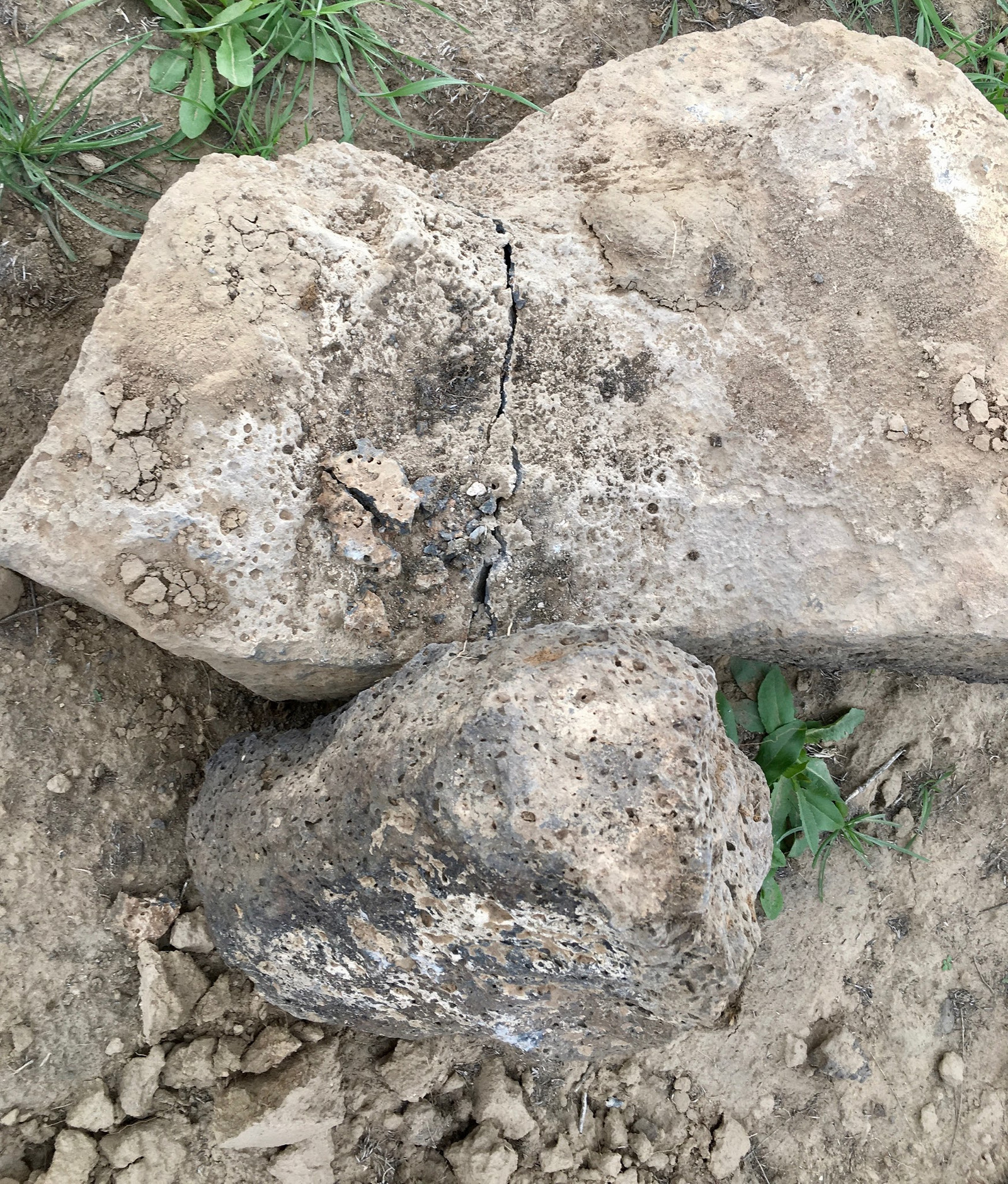
I used the guideline of, “When both sides are on the bump stops, I should probably go unload.” Perks of leaf springs! One of very few perks of leaf springs… but they do make some really good load indicators!
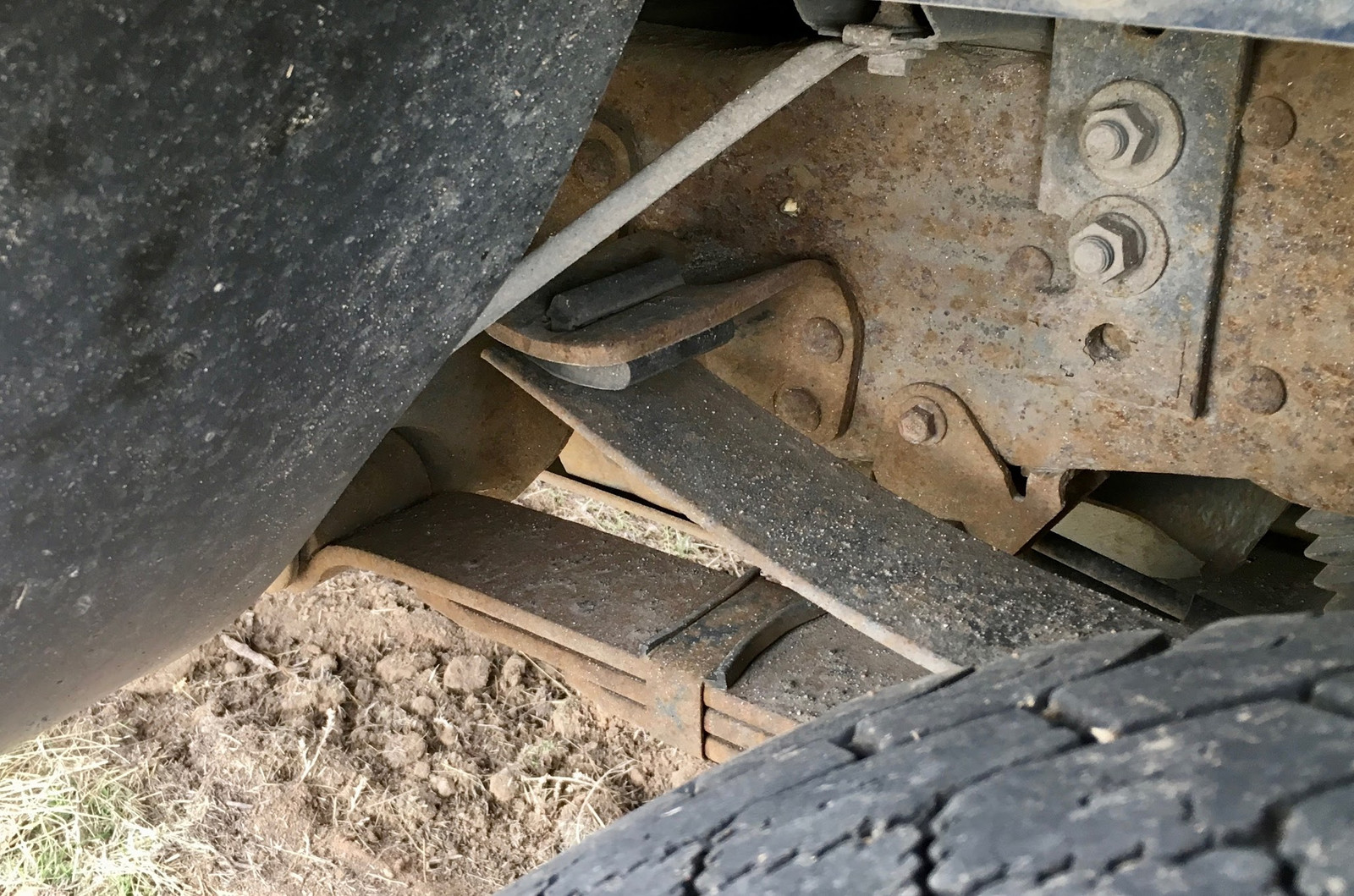
Are you wondering why I built a stone cutting bench? This whole process should help you understand why!
Ripping the firebreaks is mostly a process of “go back and forth until you’re happy with the results.” I found that things work best with the tractor running at full governed RPM, with the blade digging deep, turning over the soil and generally disrupting anything growing. For grass sprouting in the firebreaks, you can kill it in a few ways. You can rip it up and turn it over, which exposes the roots to the air, or you can just cover it with a lot of dirt and deprive it of light and air. Either way is fine.
The trick is dealing with the rocks. If the blade is cutting deep, you will hit rock. Depending on the size, this will rip the rock out, it will rock it slightly, or it will drag the tractor to an abrupt halt. The last case is rather jarring, but if the dirt is soft enough, the tires will move some dirt before stalling the motor so there’s enough warning that, if you’re quick, you can clutch, find neutral, and lift the blade a few inches before proceeding forward. Or you restart the tractor and do the same thing.
After a bunch of passes of dragging dirt around and removing rocks (mostly removing rocks), I ended up with something resembling a firebreak! The key to a good firebreak is having a lot of “not burnable stuff.” Dirt is not burnable. Grass is burnable. This is a good chunk of “not burnable.”
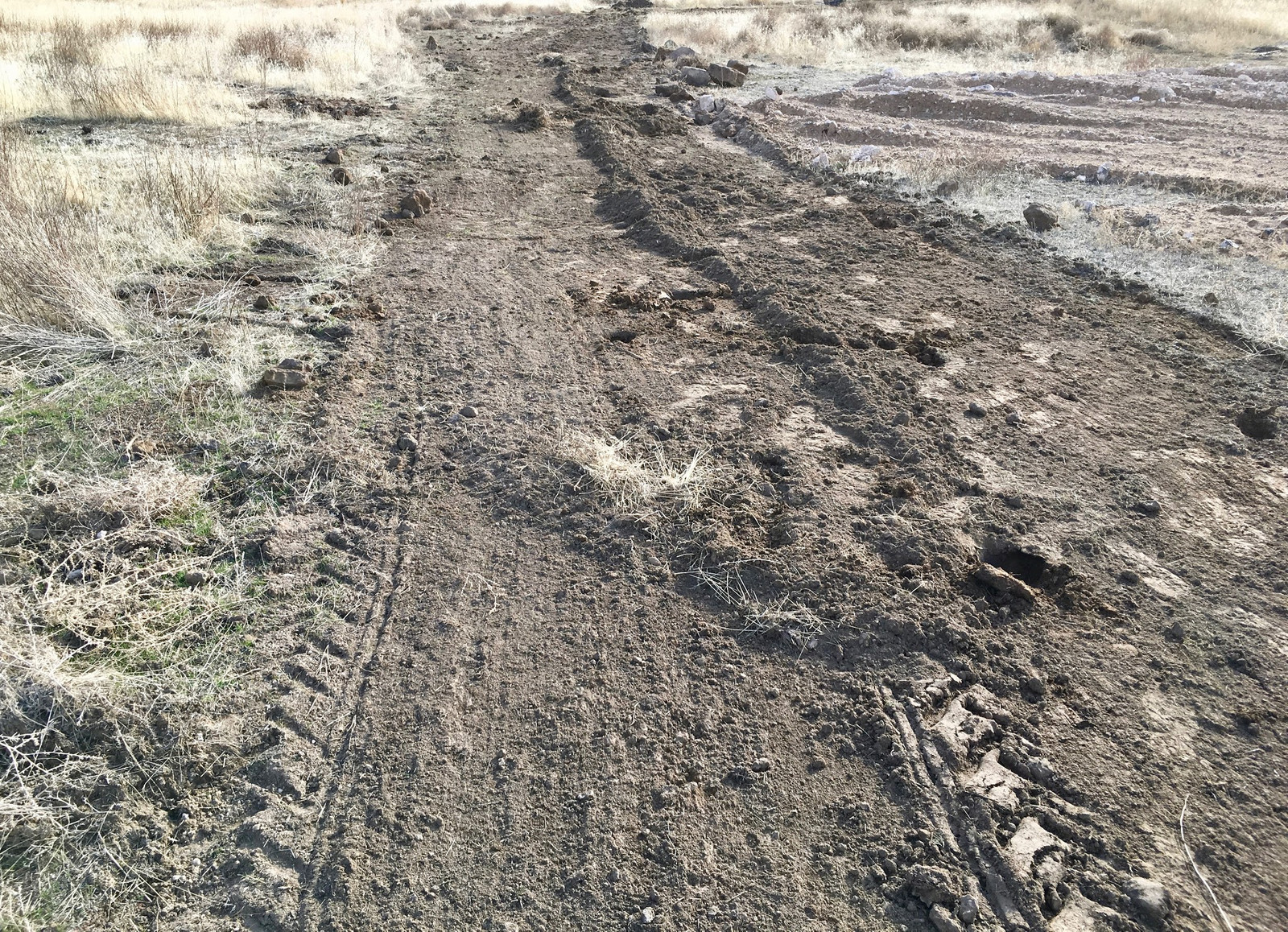
Really, I just move dirt back and forth with the blade until I’m happy with how much grass is either ripped up or covered. The grass grows back quickly, and this spring has required an hour or so of tractoring every week or two, depending on moisture. I expect that will drop back a lot this summer. Yes, it’s dusty work, but you can rip upwind, if you care.
Once things dried out a bit, I had something like this in a chunk of firebreak. Grass in the middle, but even this is OK-ish for a firebreak - it won’t pass a flame across it. However, I have a tractor.
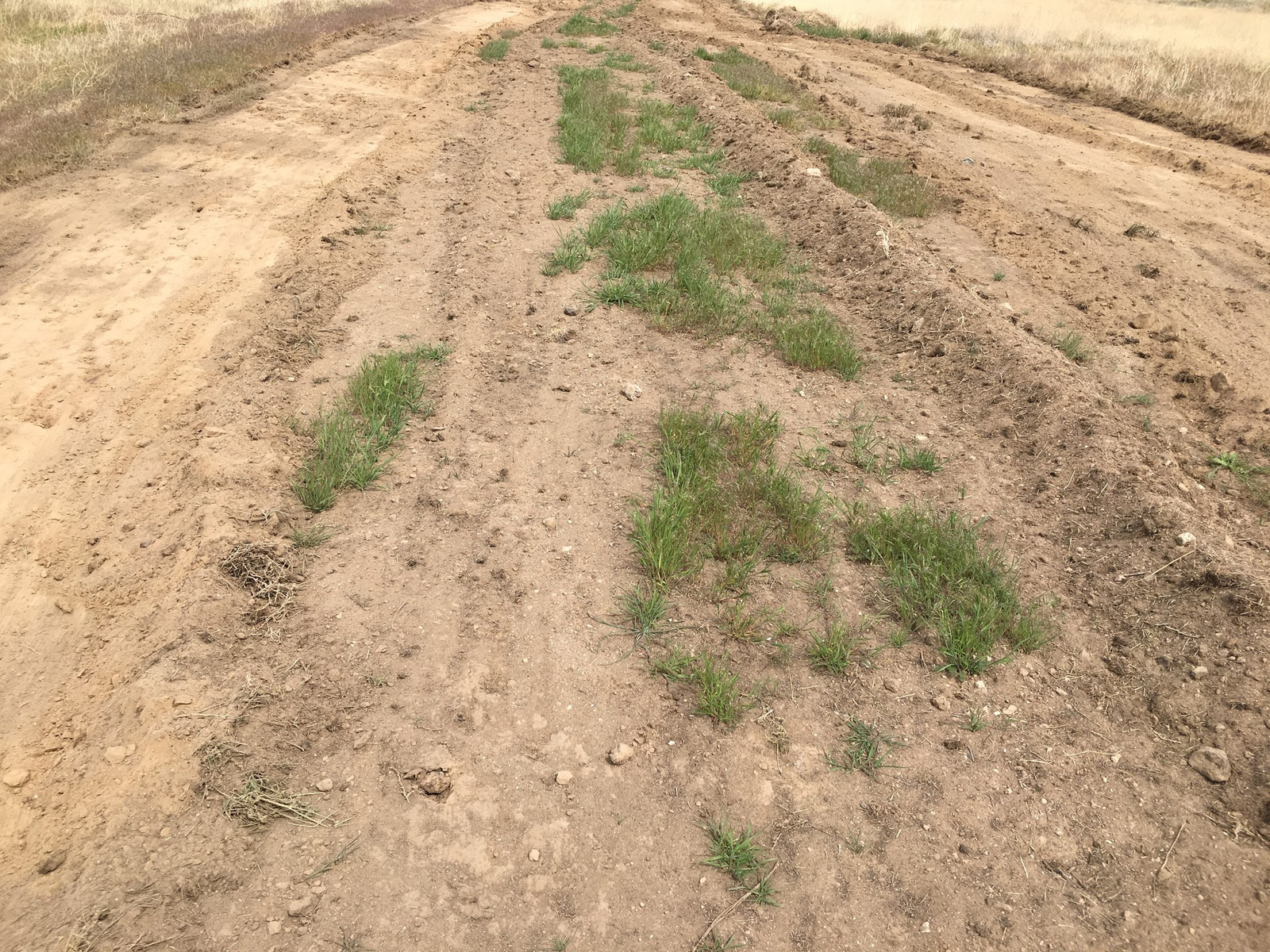
A pass or two with the blade, and this is the result: Better firebreak! Some grass ripped up and turned over, some just covered. Don’t care! It’s not going to burn, and that’s the key.
Eventually, I plan to turn this into more of a road. Toss a few (ok, a lot of) tons of road mix over it and roll it, then keep it from growing things. I expect a few readers to complain about my use of plant deterrent, and I don’t really care. I’d rather fire not propagate onto parts of the property I care about, and this is a good way to accomplish that.
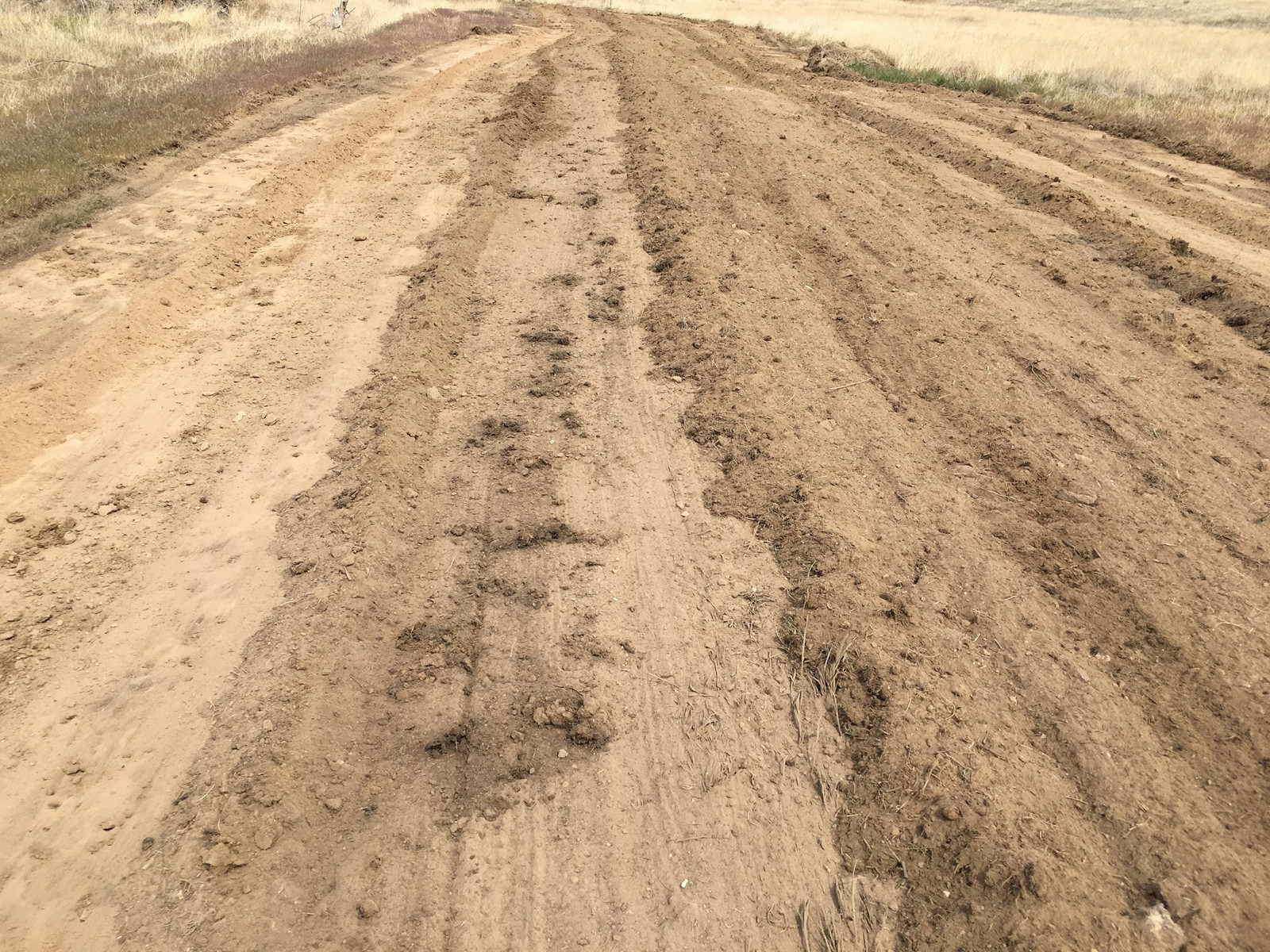
I’ve actually cut a few breaks. Some on our property, some heading down the hill onto neighboring property. I’m not going to poison the stuff off our property, but if I can keep cheatgrass fires from spreading, that’s of direct use to me. See previous comments about fireworks.
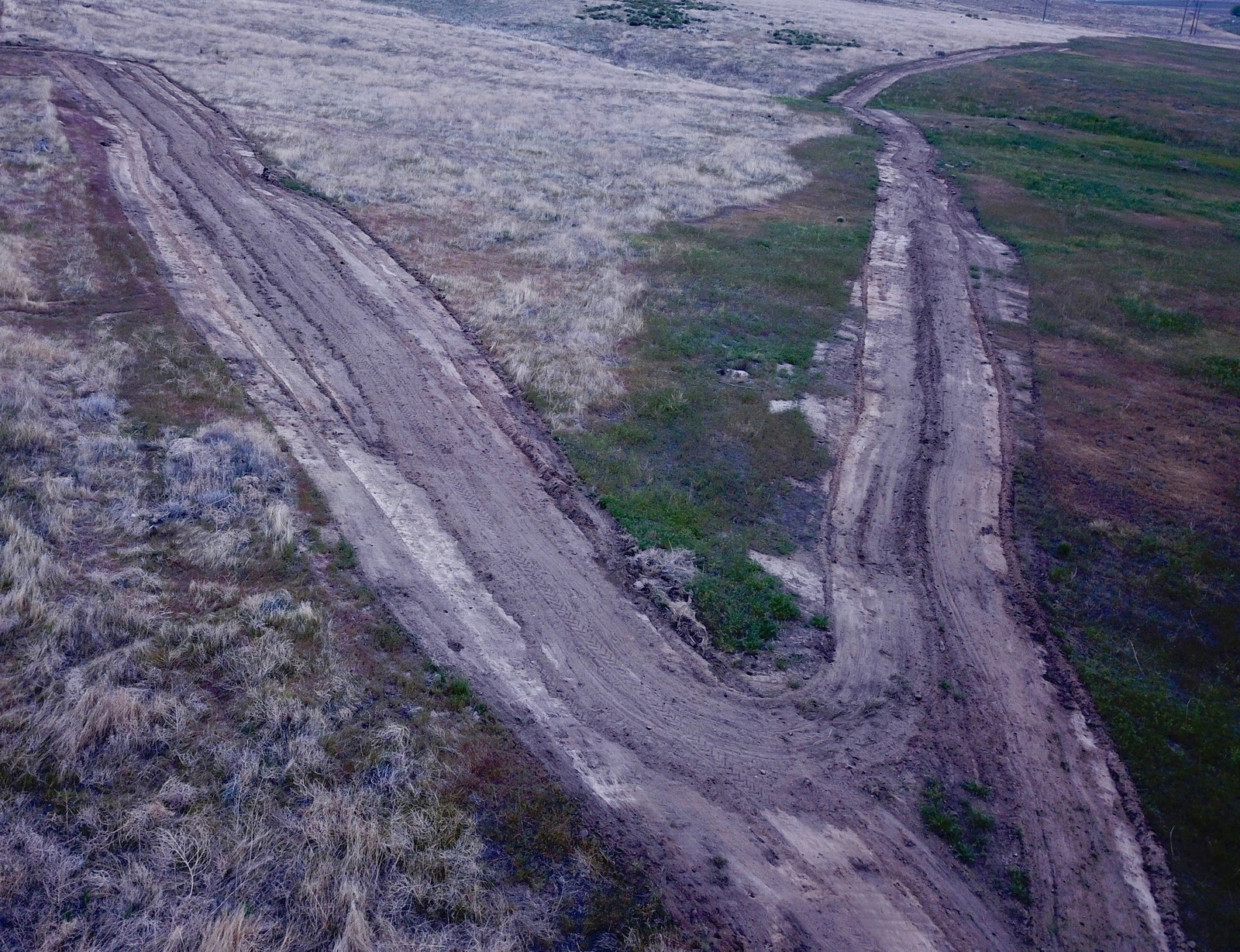
Storage Improvements
One of the main problems we had when we moved in is that we didn’t have much in the way of outdoor storage. We eventually moved a little shed back over from where it had been moved, but it was only barely better than nothing. It mostly collected swirling dust, and random critters loved it.
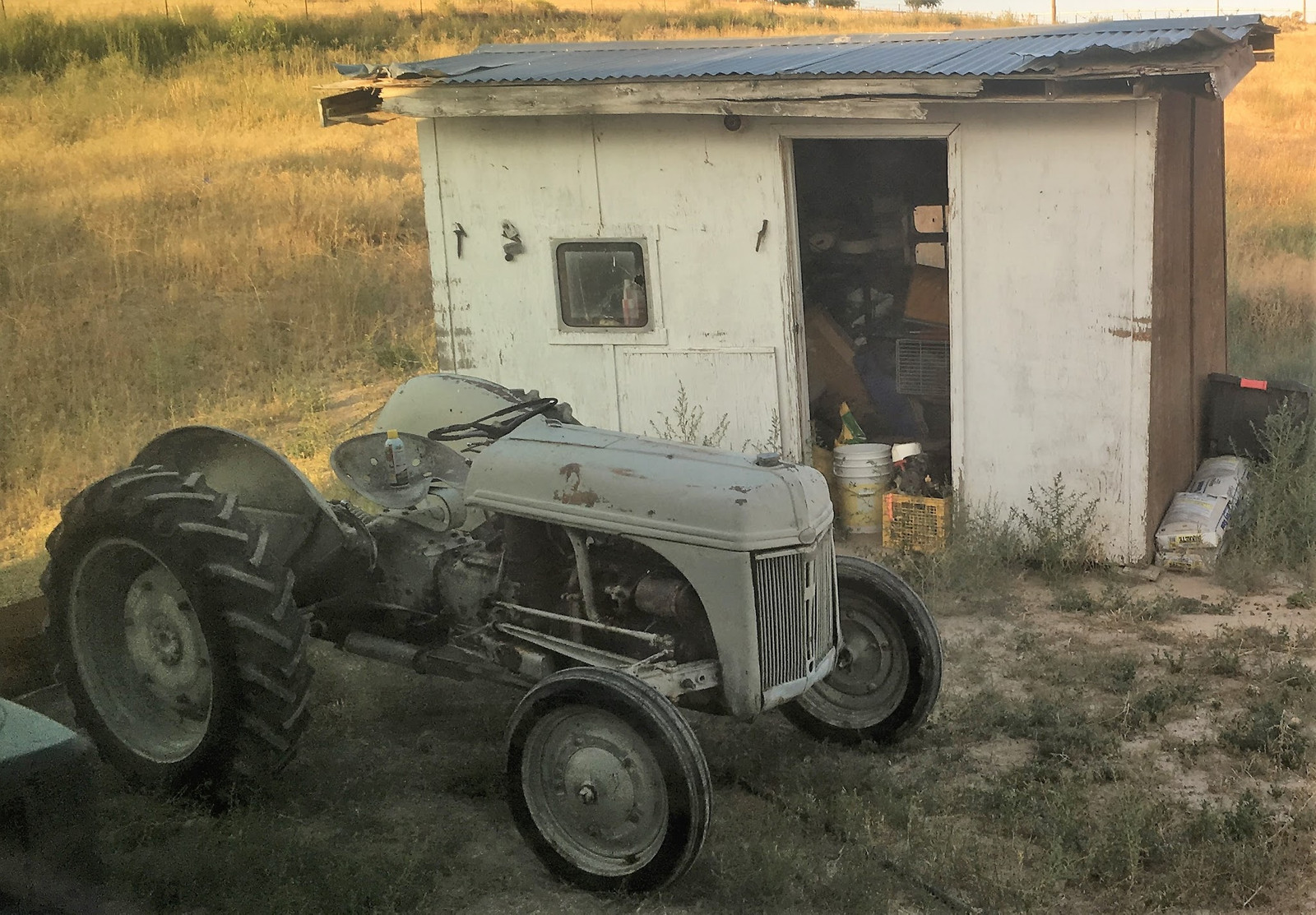
In 2017, we tore that down in the process of doing the driveway. It was surprisingly sturdy for how flimsy it felt, but we got it torn down and out of the way. “Doing the driveway” involved expanding out the flat area around our house and bringing in an awful lot of road mix. We’d still like to get some nice topping gravel (something white, or at least not road mix colored), but it’s a low priority at the moment.
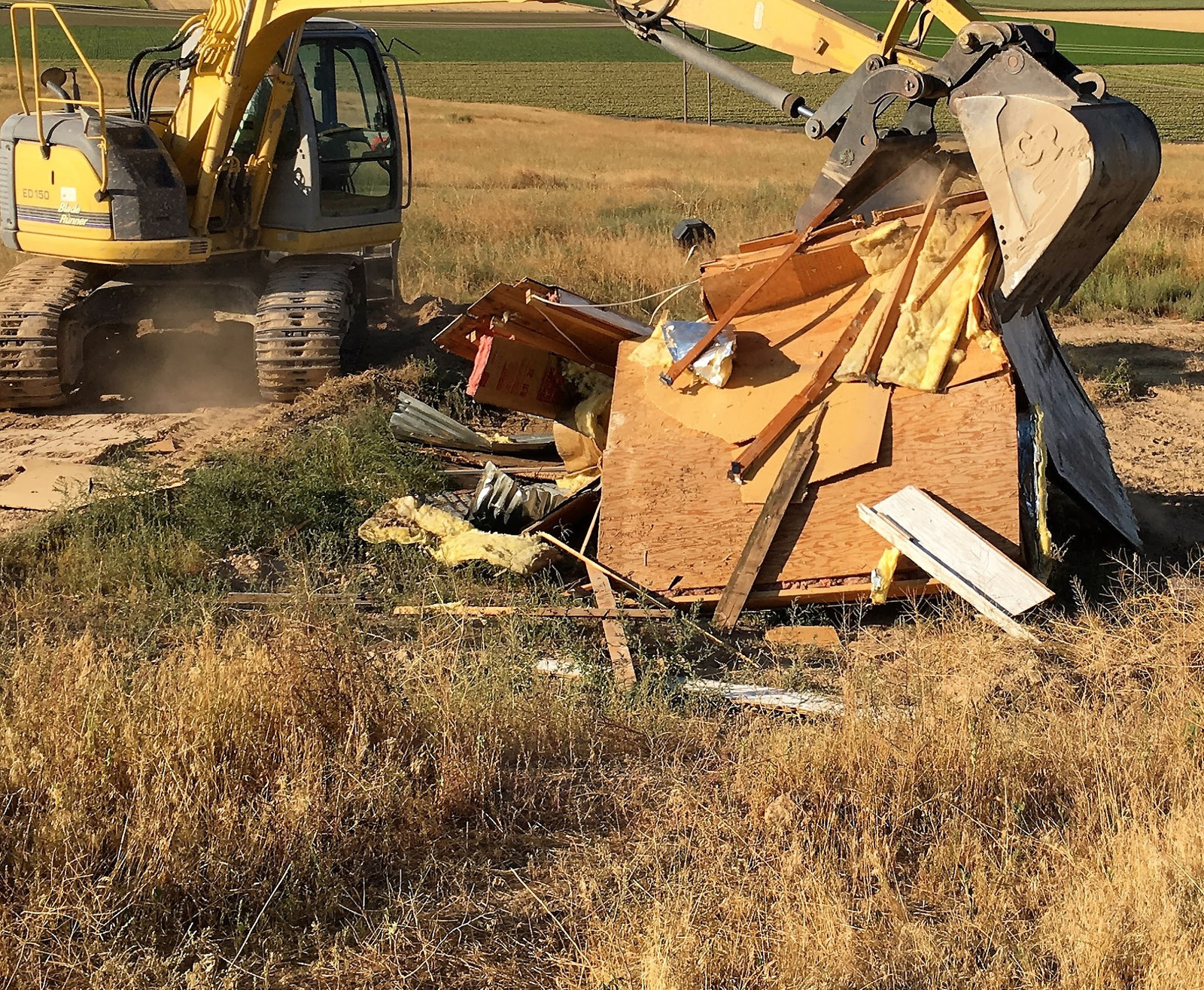
With that out of the way, and the driveway opened up, we had room to put in proper storage! We went with a garden shed, a shipping container, and a carport in the middle to shelter the vehicles somewhat. It’s more space than a garage, and the combination ran us a good bit less than a garage would have, while offering better protected storage (eventually we’ll be storing antique cars, and the shipping container offers far better protection against the elements).
I’ve talked about the shed before (in the context of building shelving), but the shed is used for general garden equipment storage, motorcycle storage in the winter (it’s really tight with all the bikes in there, but it’s workable, and I ride the Ural all winter anyway so it doesn’t get stored). With the shelves, I can store a lot, and while it does get tight with all the equipment in there, I can still move around. I’m pretty bad about leaving lawn mowers out in the sun in the summer, so it’s not as tight as it might seem.
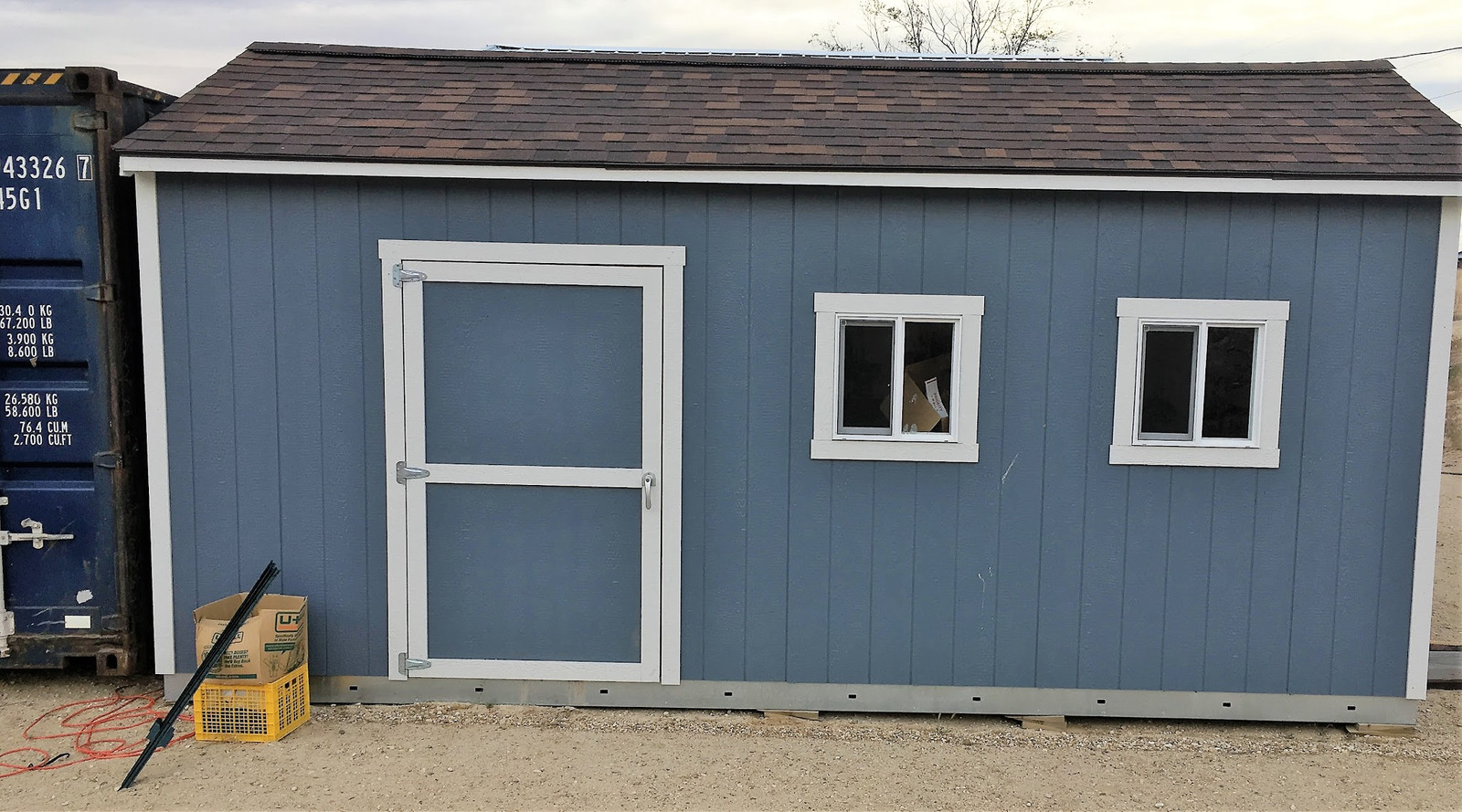
Next to it, we have the shipping container. It’s a proper 40’ unit, and right now it serves as long term storage for things and a workshop. I’m not making efficient use of it at all, and I have plenty of plans to improve that, but only so much time for projects right now. I’m keeping up on the property maintenance, but I don’t have time for a lot of improvements at the moment.
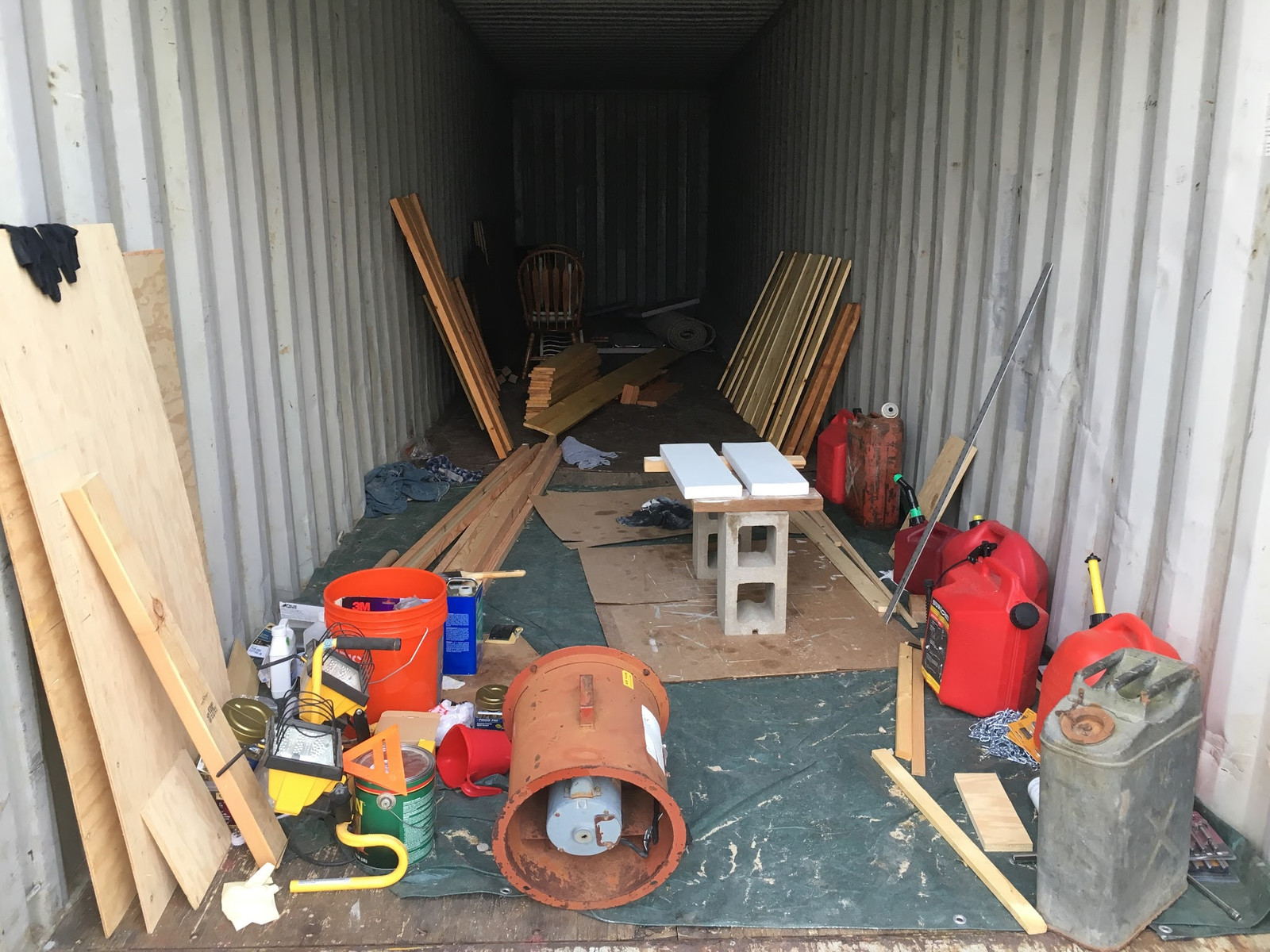
After I’ve done some painting in the container, and the paint has dried, it’s nice to air it out. One could do this by leaving the doors open - but overkill is awesome, and I found overkill in another junk pile up the hill (if one gets the impression I’m just slowly relocating the junk piles, I get that impression too).
There are fans. Then there are FANS. This thing? You might call it a FAN!!! It’s apparently part of an old potato silo ventilation system, and it has a grate to try and keep things out of the front. That matters, because this thing is serious. Imagine a lawn mower motor powered fan, and you start getting the idea of this thing. I haven’t popped a breaker with it yet, but I have 20A circuits. It pulls a ton of power, and moves an absolutely insane amount of air. The thrust will try to scoot it across the floor, and you keep things away from the rear because the suction is terrifying. This will vent out a shipping container in 10 minutes, no problem. I’ve thought about doing some ducting to help it push air to the back, but I just don’t see a reason to - it does a great job already. Not bad for something sitting on the hillside for quite a few years!
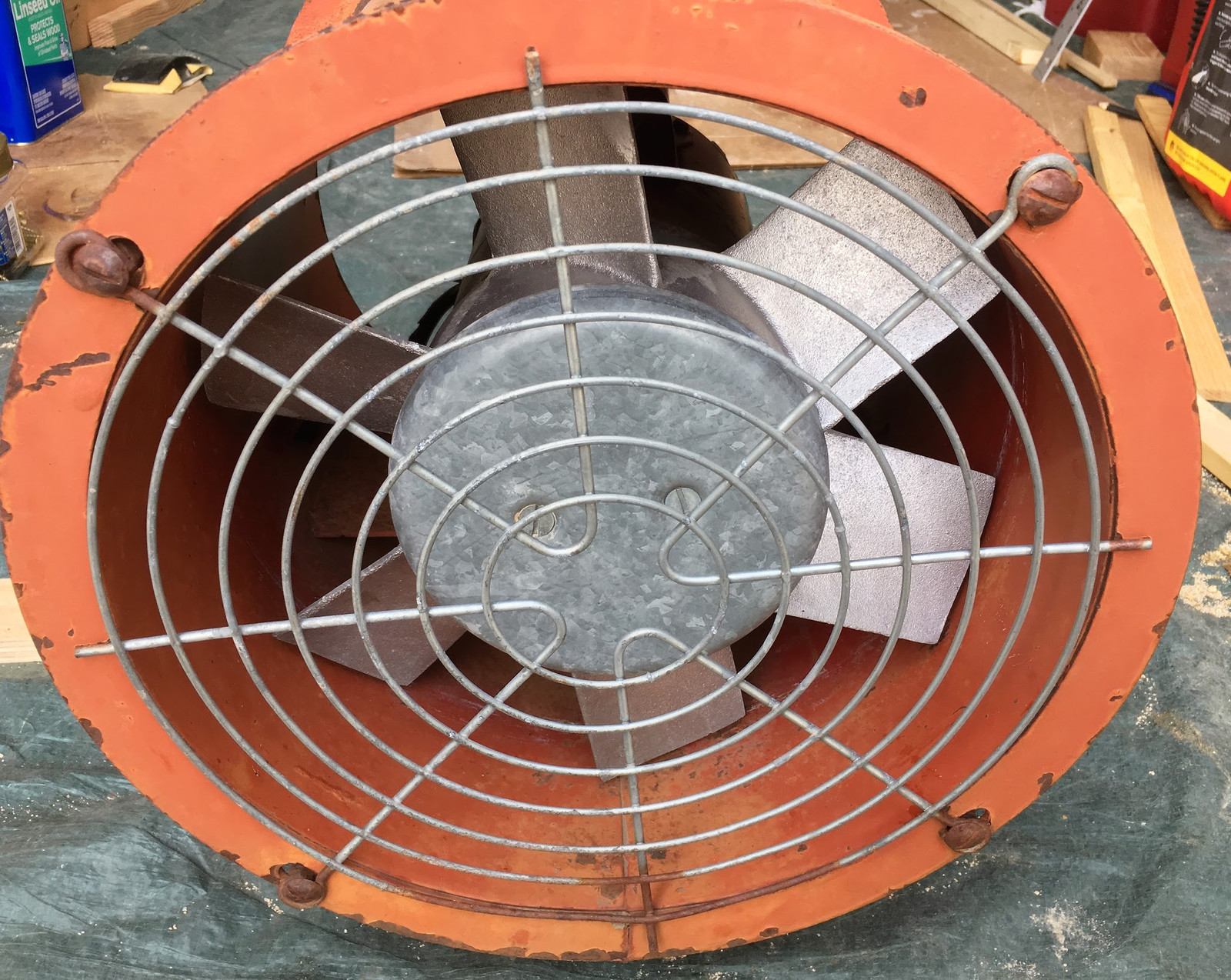
Property Progress!
So, that’s what I’ve been up to around our hillside. Projects are slow this summer, largely because I’ve been devoting a lot of my weekends to helping with a church buildout (taking an old church building that got away from the Gospel and reworking it into something far, far more useful). But I’ve got some good fire breaks in place that I can maintain until I turn them into roads, and a lot of the other stuff I’ve done is working well enough. I should have left a bigger gap between the cinderblocks and the house, but I’ll resolve that soon enough with some smaller deck builds.
And, if anyone wants any basalt, please, let me know! I’ll ship you a hunk of hand-mined Idaho basalt for the cost of shipping (really). The contact form is on the right, and I’ll find something that fits in a USPS Flat Rate Box. The maximum domestic weight in those is 70lb, and I think I can get close!
Book Review: Chaos Monkeys
I realized I haven’t been posting book reviews, even though I’ve been writing them, so I’ll try to catch up in the next few weeks.
Chaos Monkeys: Obscene Fortune and Random Failure in Silicon Valley
Have you ever wanted to pull back the curtain that shrouds Silicon Valley in mystery, and peer at the raw genius that drives world changing companies? To see the brilliant venture capitalists at work, as they find the next big thing? To see how a product is built at Facebook, or how the various companies interact together in this modern internet age?
Read this book.
Warning: You probably won’t be nearly as happy eating the sausage afterwards. This follows one guy’s trip through the Silicon Valley factory - working at startups, starting a startup, Y Combinator, venture capital, the buyout, deceit, backstabbing, designing new products, fighting with management, getting fired, and walking on the edge of lawsuits. In other words, Silicon Valley operating normally.
It’s an eye opening look at what’s behind the scenes of the surface polished products we use and how they’re created. It’s long, but a quite enjoyable read all the way through - I’d even call it a page turner.
Comments
Comments are handled on my Discourse forum - you'll need to create an account there to post comments.If you've found this post useful, insightful, or informative, why not support me on Ko-fi? And if you'd like to be notified of new posts (I post every two weeks), you can follow my blog via email! Of course, if you like RSS, I support that too.
